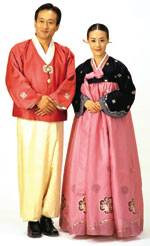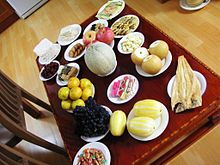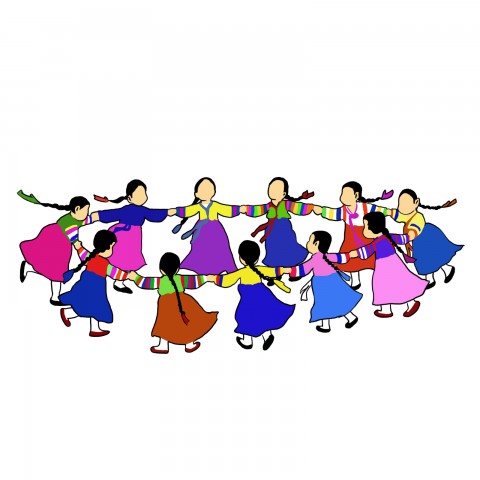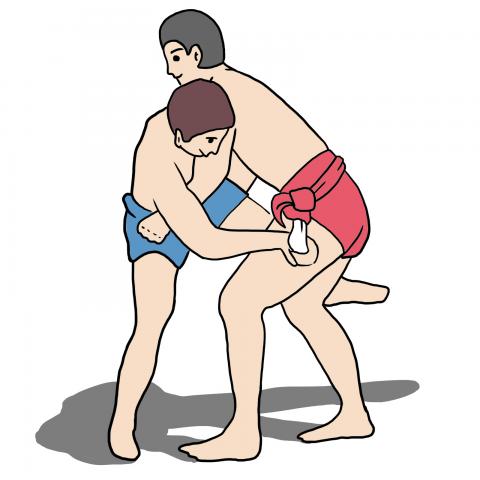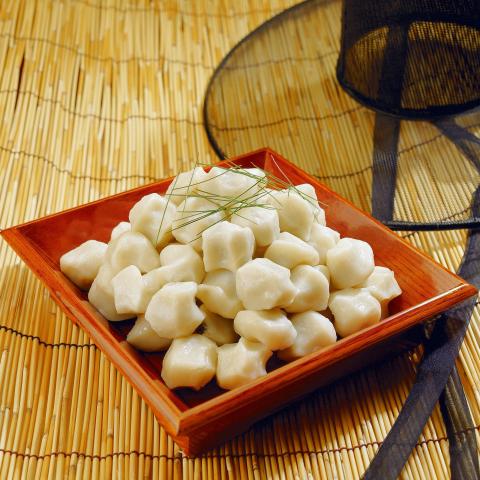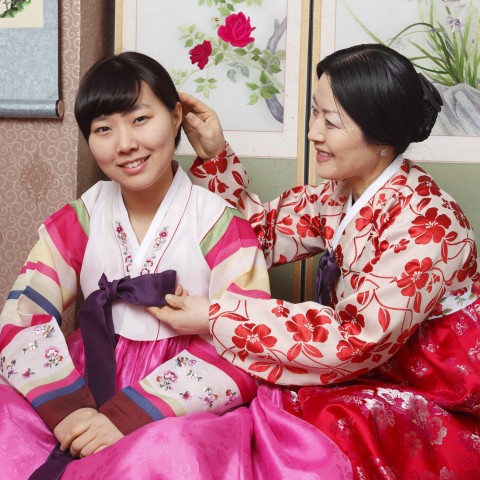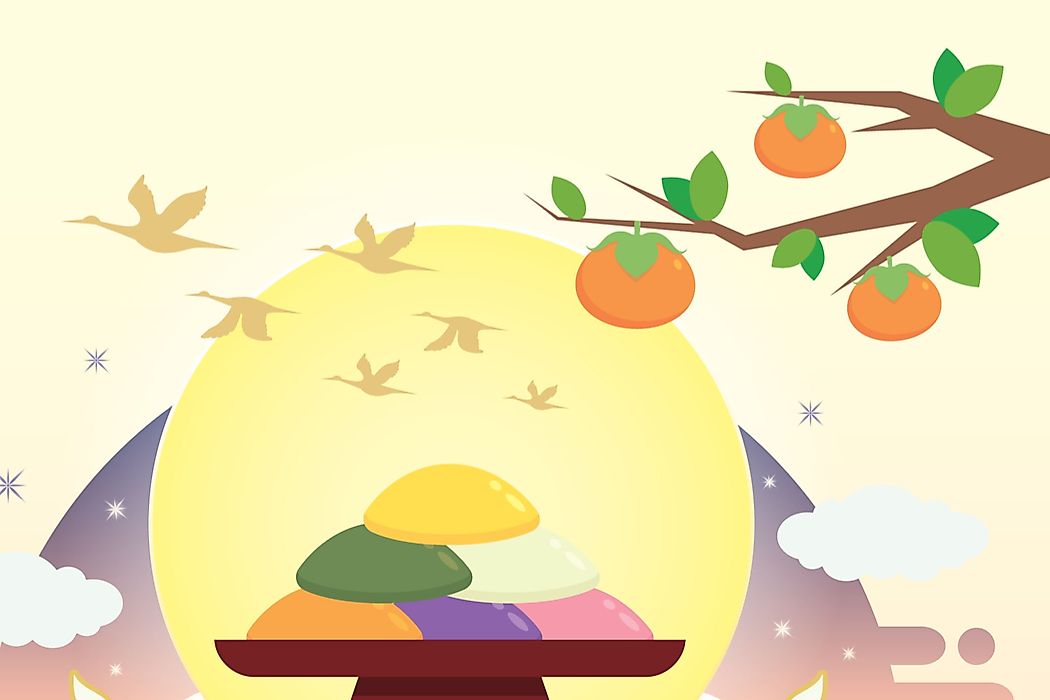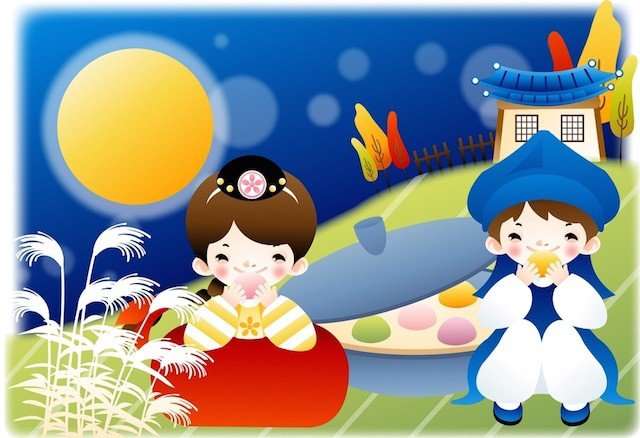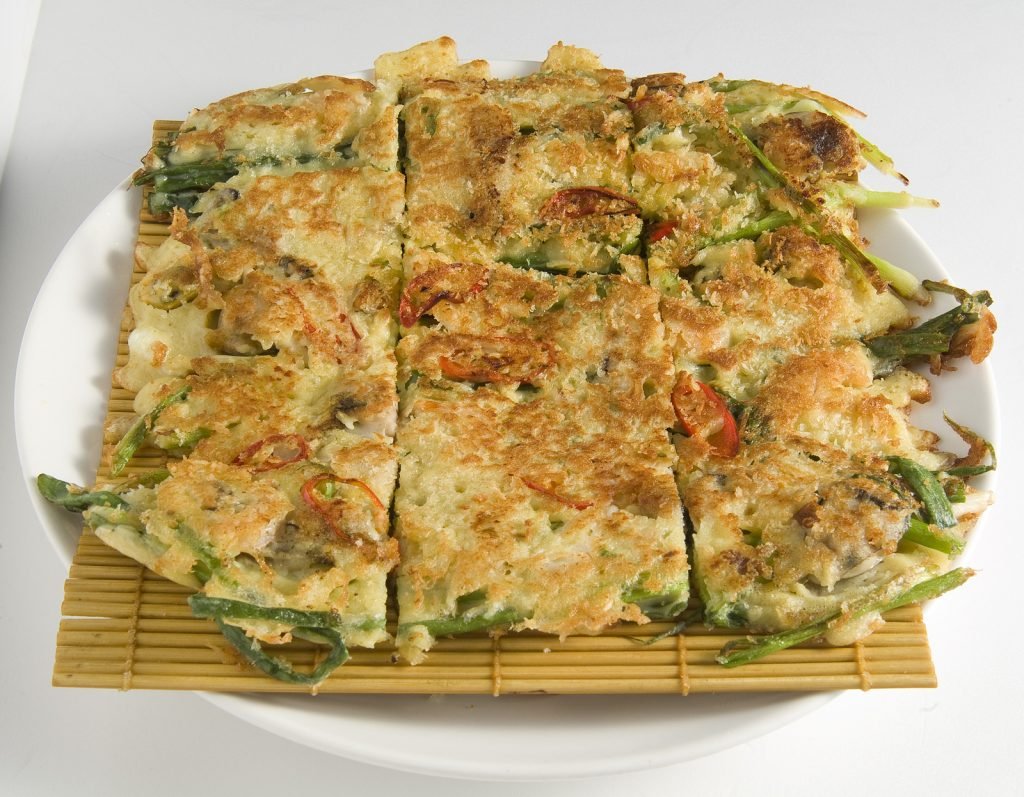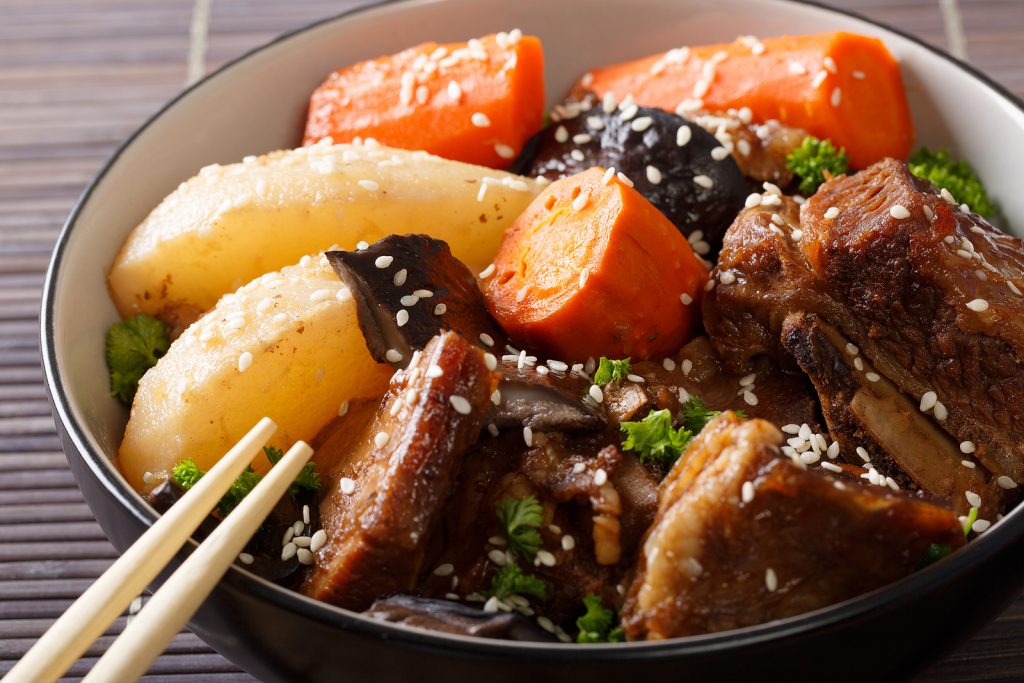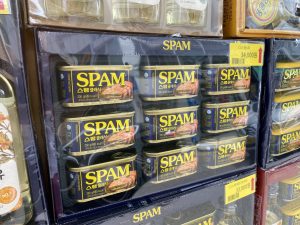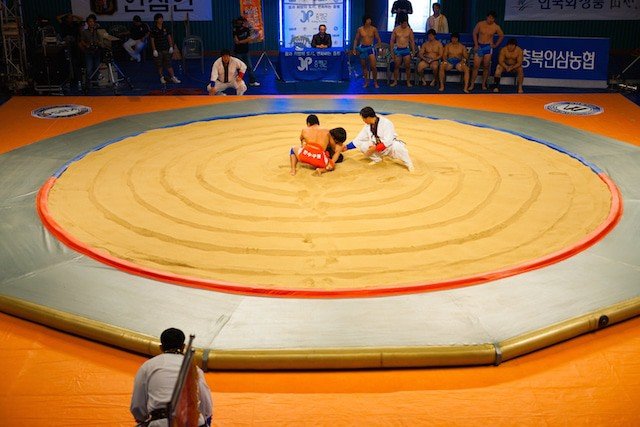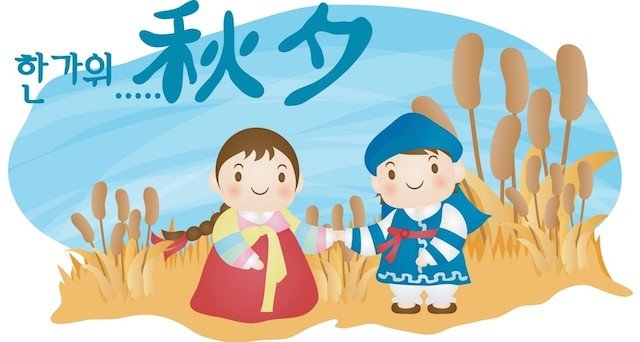| Chuseok | |
|---|---|
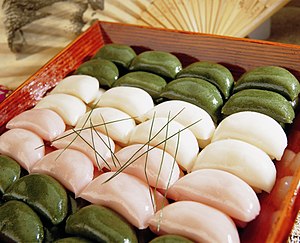
Songpyeon, a type of tteok to celebrate Chuseok. |
|
| Official name | Chuseok (추석, 秋夕) |
| Also called | Hangawi, Jungchujeol |
| Observed by | Koreans |
| Type | Cultural, religious (Buddhist, Confucian, Muist) |
| Significance | Celebrates the harvest |
| Observances | Visit to their family’s home town, ancestor worship, harvest feasts with songpyeon and rice wines |
| Begins | 14th day of the 8th lunar month |
| Ends | 16th day of the 8th lunar month |
| Date | 15th day of the 8th month of the Chinese lunar calendar |
| 2022 date | 9 September – 11 September |
| 2023 date | 28 September – 30 September |
| 2024 date | 6 September – 8 September |
| 2025 date | 16 September — 18 September |
| Frequency | Annual |
| Related to | Mid-Autumn Festival (in China) Tsukimi (in Japan) Tết Trung Thu (in Vietnam) Uposatha of Ashvini/Krittika (similar festivals that generally occur on the same day in Cambodia, India, Sri Lanka, Myanmar, Laos, and Thailand ) |
| Korean name | |
| Hangul |
추석 |
|---|---|
| Hanja |
秋夕 |
| Revised Romanization | chuseok |
| McCune–Reischauer | ch’usŏk |
| IPA | [tɕʰusʌk̚] |
| Original Korean name | |
| Hangul |
한가위 |
| Revised Romanization | han-gawi |
| McCune–Reischauer | han’gawi |
| IPA | [hɐnɡɐɥi] |
Chuseok (Korean: 추석; Hanja: 秋夕; [tɕʰu.sʌk̚], literally «autumn evening»), also known as Hangawi (Hangul: 한가위; [han.ɡa.ɥi]; from archaic Korean for «the great middle (of autumn)»), is a major mid-autumn harvest festival and a three-day holiday in South Korea celebrated on the 15th day of the 8th month of the lunar calendar on the full moon. In North Korea, they only celebrate for the day of chuseok.[1] Like many other harvest festivals around the world, it is held around the autumn equinox, i.e. at the very end of summer or in early autumn. It is the biggest traditional holiday in South Korea.
As a celebration of the good harvest, Koreans visit their ancestral hometowns and share a feast of Korean traditional food such as songpyeon (Korean: 송편; Hanja: 松䭏), yakgwa, fruits like Asian pear and hallabong, and rice wines such as sindoju (Korean: 신도주; Hanja: 新稻酒). and dongdongju (Korean: 동동주; Hanja: 浮蟻酒). There are two major traditions related to Chuseok: Charye (Korean: 차례; Hanja: 茶禮, ancestor memorial services at home, also known as Jesa), and Seongmyo (Korean: 성묘; Hanja: 省墓, family visit to the ancestral graves), which is usually accompanied by Beolcho (Korean: 벌초; Hanja: 伐草, tidying graves, removing weeds around them).[2] Another major custom is to prepare the family’s ancestors their favorite meals as an offering.
Origins[edit]
According to popular belief, Chuseok originates from gabae (Korean: 가배; Hanja: 嘉俳·嘉排). Gabae started during the reign of the third king of the kingdom of Silla (57 BC — 935 AD), when it was a month-long weaving contest between two teams.[3][4] On the day of Gabae, the team that had woven more cloth won and would be treated to a feast by the losing team. It is believed that weaving competitions, archery competitions, and martial arts demonstrations were held as part of the festivities.[5]
Many scholars also believe Chuseok may originate from ancient shamanistic celebrations of the harvest moon.[4] New harvests are offered to local deities and ancestors, which means Chuseok may have originated as a worship ritual.[6] In some areas, if there is no harvest, worship rituals are postponed, or in areas with no annual harvest, Chuseok is not celebrated.[citation needed]
Traditional customs[edit]
Another table with many traditional food offerings on it
In contemporary South Korea, on Chuseok, masses of people travel from large cities to their hometowns to pay respect to the spirits of their ancestors.[7] Chuseok celebrates the bountiful harvest and strives for the next year to be better than the last. People perform ancestral worship rituals early in the morning. Then, they visit the tombs of their immediate ancestors to trim plants, clean the area around the tomb, and offer food, drink, and crops to their ancestors.[7] The rest of the day is spent playing folk games and bonding with the family members. South Koreans consider autumn the best season of the year due to clear skies, cool winds, and it is the perfect harvesting weather. Harvest crops are attributed to the blessing of ancestors. Chuseok is commonly incorrectly translated as «Korean Thanksgiving» in American English despite the holidays being vastly different in origin and celebration.[8] Although most South Koreans visit their families and ancestral homes, there are festivities held at the National Folk Museum of Korea. Many places are closed during this national holiday, including banks, schools, post offices, governmental departments, and stores. Airline tickets to South Korea around the festival are usually sold out three months in advance and roads and hotels are overcrowded.[9]
Charye[edit]
Charye is one of the ancestral memorial rites celebrated during Chuseok, symbolizing the abundance of the harvest season and honoring ancestors and past generations.[10] The rite involves the gathering of families in holding a memorial service for their ancestors through the harvesting, preparation and presentation of special foods as offerings.[11] Preparation for the food usually takes hours and many families start the cooking process early in the morning. The rite embodies the traditional view of spiritual life beyond physical death, respecting the spirits of the afterlife that now also serve to protect their descendants. The foods offered vary across provinces depending on what is available, but commonly feature freshly harvested rice, rice cakes (songpyeon) and fresh meat, fruit and vegetables.[12] The arrangement of the foods of Charye on the table is also notable: traditionally rice and soup are placed on the north and fruits and vegetables are placed on the south; meat dishes are served on the west and in the middle, and rice cake and some drinks such as makgeolli or soju are placed on the east. These details can vary across regions.[13]
Hanbok[edit]
The hanbok (in South Korea) or Choson-ot (in North Korea) is the traditional dress that the Korean people wear on special holidays and formal and semi-formal occasions, such as Chuseok, Lunar New Year, and weddings. The term «hanbok» literally means «Korean clothing.» The basic structure of the hanbok consists of the jeogori jacket, baji pants, chima skirt, and the po coat. The design of the hanbok remains unchanged to this day and is designed in a variety of colors.[14]
Food[edit]
Songpyeon[edit]
One of the major foods prepared and eaten during the Chuseok holiday is songpyeon (Hangul: 송편; 松餠), a Korean traditional rice cake[7] made with ingredients such as sesame seeds, black beans, mung beans, cinnamon, pine nut, walnut, chestnut, jujube, and honey.
When making songpyeon, steaming them over a layer of pine-needles is critical. The word song in songpyeon means a pine tree in Korean. The pine needles not only contribute to songpyeon’s aromatic fragrance, but also its beauty and taste.[15][16]
Songpyeon is also significant because of the meaning contained in its shape. However, some songpyeon are shaped like a ball. Songpyeon’s rice skin itself resembles the shape of a full moon, but once it wraps the stuffing, its shape resembles the half-moon. Since the Three Kingdoms era in Korean history, a Korean legend stated that these two shapes ruled the destinies of the two greatest rival kingdoms, Baekje and Silla. During the era of King Uija of Baekje, an encrypted phrase, «Baekje is full-moon and Silla is half-moon» was found on a turtle’s back and it predicted the fall of the Baekje and the rise of the Silla. The prophecy came true when Silla defeated Baekje. Ever since Koreans have believed a half-moon shape is an indicator of a bright future or victory.[16] Therefore, during Chuseok, families gather together and eat half-moon-shaped Songpyeon under the full moon, wishing for a brighter future.[17] There’s a belief that if a single woman makes a pretty songpyeon, she will find a great husband, and if a pregnant woman makes a pretty songpyeon, she will have a pretty daughter.[18]
Hangwa[edit]
Another popular Korean traditional food that people eat during Chuseok is hangwa. It is a general term to categorize sweet foods made with tteok, meaning rice cake. It is an artistic food decorated with natural colors and textured with patterns. Hangwa, also known as Hang, is made with rice flour, honey, fruit, and roots. People use edible natural ingredients to express various colors, flavours, and tastes. Because of its decoration and nutrition, Koreans eat hang not only during Chuseok, but also for special events, for instance, weddings, birthday parties, and marriages.[19]
The most famous types of hangwa are yakgwa, yugwa, and dasik. Yakgwa is a sweet honey cookie which is made of fried rice flour dough ball and yugwa is a fried cookie consisting of glutinous rice mixed with honey water, and cheongju (rice wine). Dasik is a tea cake that people enjoy with tea.[20]
Baekju[edit]
A major element of Chuseok is alcoholic drinks. Liquor drunk on Chuseok is called baekju (백주, 白酒, literally «white wine») and nicknamed sindoju (신도주, 新稻酒, literally «new rice liquor») as it is made of freshly harvested rice.[21][22]
Kooksoondang, a maker of Korean traditional liquors, restored «Yihwaju», rice wine from the Goryeo era (918–1392), and «Songjeolju» that has been widely enjoyed by Joseon (1392–1910) aristocrats. Its «Jamyang Baekseju» package comprises a variety of liquors ― Jayang Baekseju, Jang Baekseju, Baekokju ― that are claimed to enhance men’s stamina.[23]
Adults say that if you drink the alcoholic beverage which the ancestors have drunk; there will be nothing you’ll be scared of.[citation needed]
Others[edit]
Other foods commonly prepared are japchae, bulgogi, an assortment of Korean pancakes also known as jeon, saengseon (fried fish), tteokguk (rice cake soup), and fruits.
Gifts[edit]
History of Chuseok gifts[edit]
The Korean people started sharing daily necessities, such as sugar, soap or condiments, as Chuseok gifts in the 1960s. The gifts have changed since the Korean economy has developed. In the 1970s, Korean people had more options for Chuseok gifts; examples include cooking oil, toothpaste, instant coffee sets, cosmetics, television and rice cookers. People chose gift sets of fruit, meat and cosmetics in the 1980s. In the 1990s, people used gift vouchers for Chuseok. In the 21st century, more sophisticated gifts, such as sets of sweet desserts, spam, fruits, health supplements, and skincare have become the most popular options for Chuseok gifts.[24]
Types of Chuseok gifts and prices[edit]
Some extravagant gifts can be purchased: one kilogram of wild pine mushrooms, which are expensive because they cannot be artificially grown, (560,000 won) US$480.27 and red ginseng products (1.98 million won) US$1698.11. However, the most exorbitantly priced gift is six bottles of wine at Lotte Department Store for a staggering (33 million won) US$28,301.89.[25]
Chuseok gift sets are big business in Korea and prices are typically inflated around the holiday.[26]
Folk games[edit]
A variety of folk games are played on Chuseok to celebrate the coming of autumn and rich harvest. Sonori is a folk performance where Village folk dress themselves to resemble a cow or turtle and go from house to house along with a nongak band playing pungmul music. Other common folk games played on Chuseok are talchum (mask dance), board game called Yut Nori, (also known as Yunnori, Nyout, and Yout), archery, ssireum,(Korean wrestling), and juldarigi;[27] folk games vary by region.
Ssireum[edit]
Ssireum (Hangul: 씨름) is the most popular Korean sport played during Chuseok and contests are usually held during this holiday. Scholars have found evidence for ssireums dating back to the Goguryeo dynasty, Ssireum is assumed to have 5000 years of history. Two players wrestle each other while holding onto their opponent’s satba, a red and blue band. A player loses when his upper body touches the ground, and the winner becomes Cheonha Jangsa, Baekdu Jangsa, or Halla Jangsa, meaning «the most powerful». The winner gets a bull and 1 kg (2.2 lb) of rice as the prize.[28] Due to its popularity among both the young and the old, ssireum contests are held more frequently, not limited to important holidays.
Taekkyon[edit]
Taekkyon (Hangul: 태껸 or 택견) is one of the oldest traditional martial arts of Korea. Taekkyon was very popular during the Joseon period (1392-1897) where it was practised alongside Ssireum during festivities, including Chuseok. Though originally a hand-to-hand fighting method, plebs used a more tamed version alike to a kicking game. The practitioner uses the momentum of his opponent to knock him down through kicks, swipes and pushes.[29] Tournaments between players from different villages were carried out, starting with the children («Aegi Taekkyon») before finishing with the adults.
Taekkyon almost disappeared during the Japanese occupation (1910-1945) but is now considered a cultural heritage of Korea (1983) and a UNESCO intangible cultural item (2011).[30]
Ganggangsullae[edit]
The Ganggangsullae (Hangul: 강강술래) dance is a traditional folk dance performed under the full moon in the night of Chuseok.[31] Women wear Korean traditional dress, hanbok, make a big circle by holding hands, and sing a song while going around a circle. Its name, Ganggangsullae, came from the refrain repeated after each verse, and contains no actual meaning.
The dance originated in the southern coastal area of Korea. To watch a video clip of the Ganggangsullae dance, click here.[clarify]
For other folk games, they also play Neolttwigi (also known as the Korean plank), a traditional game played on a wooden board.[32]
Juldarigi[edit]
Juldarigi (Hangul: 줄다리기), or tug-of-war, was enjoyed by an entire village population. Two groups of people are divided into two teams representing the female and male forces of the natural world. The game is considered an agricultural rite to predict the results of the year’s farming. If the team representing the female concept won, it was thought the harvest that year would be rich.
Chicken Fight (Dak SSa Umm)[edit]
Korean people used to watch chicken fights (Hangul: 닭싸움), and learned how chickens fought; a game inspired by such was invented.
To play the game, people are separated into two balanced groups. One must bend his or her leg up and hold it bent with the knee poking out. The players must then attack each other with their bent knees, having to eliminate them by making their feet touch the ground; the last player holding up his or her knee wins.
The game is about strength, speed, and balance; to stay alive, one must display the capability of fighting back.[33]
Hwatu[edit]
Hwatu (Hangul: 화투, also known as Go-Stop or Godori) is composed of 48 cards including 12 kinds. The rules of the game and the term water originated from Tujeon.
It was formerly similar to Hanafuda, but was changed due to similarities with the latter. It went through a course that made it reduced by four base colors and thinner than before, spreading throughout to turn out goods on a mass-produced basis.[clarification needed]
Chuseok in North Korea[edit]
Since Chuseok is a traditional holiday that has been celebrated long before the division of Korea, people in North Korea also celebrate Chuseok. However, the ideology that divided Korea also caused some differences between the way that the holiday is celebrated in North Korea from the way it is celebrated in South Korea.[34] In fact, North Korea did not celebrate Chuseok and other traditional holidays until the mid-1980s.
While South Koreans celebrate Chuseok by visiting and spending time with family members, most North Koreans do not have any family gatherings for the holiday. Some, especially those in working classes, try to visit their ancestors’ gravesites during Chuseok. However, social and economic issues in North Korea have been preventing visits.[35] In addition, the extremely poor infrastructure of North Korea, especially in terms of public transportation, makes it almost impossible for people to visit grave sites and their families.[36] In contrast to the poor Songbun lower class North Koreans, middle and elite classes enjoy the holiday as they want, easily traveling wherever they want to go.[36]
See also[edit]
- Hansik, another Korean holiday for ancestral rituals
- List of Buddhist festivals
- List of harvest festivals
- List of festivals in South Korea
- Public holidays in South Korea
- List of Korean traditional festivals
Sources[edit]
- The Academy of Korean Studies, ed. (1991), «Chuseok», Encyclopedia of Korean People and Culture, Woongjin (in Korean)
- Farhadian, Charles E. (2007). Christian Worship Worldwide. Wm. Bm. Eerdmans Publishing. ISBN 978-0-8028-2853-8.
- Korea University Institute of Korean Culture, ed. (1982). «Social Life». Korean Heritage Overview. Vol. 1. Korea University.(in Korean)
- Aviles, K. (2011, September 10). Chuseok : A Festival With Two Faces. International Business Times. Retrieved December 4, 2012[37]
- Im, J. J. (2010, September 23). Daily NK — Welcome to Chuseok, North Korean Style. DailyNK. Retrieved December 4, 2012[38]
- Kim, K.-C. (2008). Ganggangsullae. UNESCO Multimedia Archives. Retrieved December 4, 2012[39]
- Korea.net. (2012, February 5). Chuseok, Korean Thanksgiving Day (English) — YouTube. YouTube. Retrieved December 4, 2012[40]
- Moon, S. H. (2008, September 16). Daily NK — New Chuseok Trends in North Korea. DailyNK. Retrieved December 4, 2012
- Official Korea Tourism. (2008, August 26). Official Site of Korea Tourism Org.: Chuseok: Full Moon Harvest Holiday, Korean Version of Thanksgiving Day. VisitKorea. Retrieved December 4, 2012
- The National Folklore Museum of Korea. (n.d.). Ancestral Memorial Rites — Charye | The National Folklore Museum of Korea. The National Folklore Museum of Korea. Retrieved December 5, 2012[41]
- TurtlePress (Martial Arts Video). (2009, May 1). SSireum Korean Wrestling History — YouTube. YouTube. Retrieved December 4, 2012[42]
- Yoo, K. H. (2009, October 5). Chuseok, North Korean Style. DailyNK. Retrieved December 4, 2012[43]
References[edit]
- ^ Passport to Korean Culture By Published by Korean Culture and Information Service Ministry of Culture, Sports and Tourism
- ^ «Chuseok (A Korean Thanksgiving)». chuseok.org. April 2021.
- ^ The Academy of Korean Studies, ed. (1991.) «Chuseok», Encyclopedia of Korean People and Culture, Woongjin (in Korean).
- ^ a b Farhadian, Charles E. (2007.) Christian Worship Worldwide. Wm. Bm. Eerdmans Publishing. ISBN 978-0-8028-2853-8.
- ^ , Yun, Sŏ-sŏk Yun. (2008.) Festive occasions: the customs in Korea, Ewha Womans University Press, Seoul. ISBN 978-8-9730-0781-3.
- ^ Korea University Institute of Korean Culture, ed. (1982.) «Social Life», Korean Heritage Overview, 1, Korea University (in Korean).
- ^ a b c «Traditional Korean Holiday, Chuseok». Imagine Your Korea. Retrieved 22 September 2016.
- ^ «Chuseok: Korean Thanksgiving Day». Asia Society. Retrieved 22 September 2016.
- ^ Lee, Cecilia Hae-Jin (2010). Frommer’s South Korea. Hoboken, N.J, Chichester: Wiley, John Wiley. pp. 21, 22, 25. ISBN 978-0470591543.
- ^ «Korean Ancestral Memorial Rites, Jerye. — South-Korea — korea4expats». Korea4expats.com.
- ^ «A time for families, food and festivities». Jejuweekly.com.
- ^ «Traditional Korean Holiday of Bountiful Harvest, Chuseok | Official Korea Tourism Organization». English.visitkorea.or.kr. Retrieved 2018-08-22.
- ^ «메세지 페이지». Nfm.go.kr.
- ^ «Chuseok Hanbok». Chuseok.org. 12 March 2022.
- ^ «Official Site of Korea Tourism Org.: Chuseok – Full Moon Harvest Holi…». Archived from the original on 21 February 2013.
- ^ a b «No Chuseok Without Songpyeon». English.chosun.com. Retrieved 27 December 2018.
- ^ «Official Site of Korea Tourism Org.: Chuseok – Full Moon Harvest Holi…». Archived from the original on 21 February 2013.
- ^ «What are the types of TTEOK 떡 (Rice Cakes) and their meanings?». Hyphe-Nated. Retrieved 9 September 2021.
- ^ «Hangwa –Korean Traditional Confectionaries Good for the Body and the Soul — INSIDE Koreabrand.net». www.koreabrand.net. Archived from the original on 18 January 2012. Retrieved 14 January 2022.
- ^ «Korea Tour Guide». English.visitKorea.or.kr. Retrieved 22 September 2016.
- ^ 임동권 (Im Dong-kwon) (1996). «Chuseok». 한국민족문화대백과사전 (Encyclopedia of Korean Culture) (in Korean). Retrieved 2021-08-18.
- ^ «Let’s Share the Happiness of Harvest on Chuseok». AgraFood. August 29, 2011. Archived from the original on 2016-12-20. Retrieved 2016-12-09.
- ^ «Chuseok, sharing the spirit of gratitude». Korea Herald. September 6, 2013. Retrieved 27 December 2018.
- ^ «한국을 대표하는 글로벌 방송! The World On Arirang!». Arirang.com. Retrieved 27 December 2018.
- ^ «Dollar : 네이버 통합검색». Archived from the original on 2021-08-20. Retrieved 2016-12-09.
- ^ «10 Ridiculously Priced Korean Chuseok Gift Sets — 10 Magazine Korea». 10mag.com. 23 September 2015.
- ^ «Chuseok Games». Chuseok.org. 13 March 2022.
- ^ What’s on Korea. (2001, July 28) Archived 2006-05-23 at the Wayback Machine
- ^ «the importance of Taekkyon in Korean traditional culture».
- ^ «Taekkyon entry on UNESCO’s world heritage list».
- ^ Seoul City. (2004, September 2) Archived 2013-04-19 at archive.today
- ^ «Festivals, events to delight on Chuseok holidays». Korea.net. Retrieved 22 September 2016.
- ^ «Wikispaces». Archived from the original on 2018-07-31.
- ^ «Chuseok— A Festival With Two Faces». International Business Times. 10 September 2011.
- ^ «Archived copy». Archived from the original on 2018-01-07. Retrieved 2018-12-27.
{{cite web}}: CS1 maint: archived copy as title (link) - ^ a b Jin, Im Jeong (23 September 2010). «Welcome to Chuseok, North Korean Style». Dailynk.com.
- ^ «Chuseok— A Festival With Two Faces». International Business Times. 10 September 2011. Retrieved 27 December 2018.
- ^ Jin, Im Jeong (23 September 2010). «Welcome to Chuseok, North Korean Style». Dailynk.com. Retrieved 27 December 2018.
- ^ Kwang-shik-CHA, Kim. «Ganggangsullae». Unesco.org. Retrieved 27 December 2018.
- ^ «Chuseok, Korean Thanksgiving Day (English)». YouTube. Retrieved 27 December 2018.
- ^ «메세지 페이지». Nfm.go.kr. Retrieved 27 December 2018.
- ^ «SSireum Korean Wrestling History». YouTube. Retrieved 27 December 2018.
- ^ Hee, Yoo Gwan (5 October 2009). «Chuseok, North Korean Style». Dailynk.com. Retrieved 27 December 2018.
External links[edit]
Media related to Chuseok at Wikimedia Commons
- Chuseok, Korean Thanksgiving Day on YouTube
- Chuseok, North Korean Thanksgiving Day on YouTube
Chuseok or hangawi is the Korean Thanksgiving festival. To answer the question, when is Korean Thanksgiving, it is on the 15th day of the 9th month of the lunar calendar. It is celebrated on the night of the fullest and brightest moon. Chuseok is a Korean harvest festival celebrated with loved ones, people travel back to their ancestral homes to celebrate this festival. A huge crowd travels back mostly in Seoul and causes a huge traffic jam during the three festive days. It is a celebration of a good harvest and a hope that the coming year will be better than the previous.
Today Korea has taken all over the world with its K-drama, K-pop, Kimchi, authentic cuisines, clothes and more. Korean culture is spreading like wildfire everywhere, and one of the most important parts of this culture is Chuseok.
Type of Holiday: Folkloric, Calendar/Seasonal
Date of Observation: Late September-early October; fifteenth day of the eighth lunar month
Where Celebrated: Korea
Symbols and Customs: Charye & Beolcho
Related Holidays: Mid-Autumn Festival
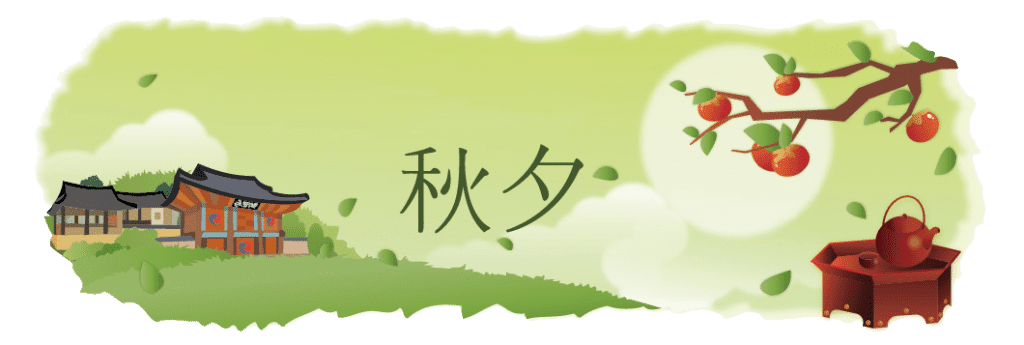
What is Chuseok Festival? 한가위
Chuseok (which literally translates to autumn eve) is one of Korea’s biggest festivals and holidays. It’s referred to as “Korean Thanksgiving”. It is also known as the Mid-autumn Festival or the Harvest Moon Festival. During Chuseok, people celebrate their ancestors, show their gratitude to them, and spend time with their families. Chuseok is a 3-day long celebration that people enjoy with traditional Korean games, vibrant traditions, customs, and a delicious array of dishes.
On this day people wake up early and perform rituals and follow chuseok traditions to worship their immediate ancestors. As the chuseok traditions follow, they visit the tombs of their ancestors to clear out the area and offer food, drinks, and crops in hope that they are looking over them at all times. South Koreans believe that the harvested crops are credited by their ancestors, hence, becoming the reason they consider autumn as the best season. It is a time when various traditional Korean dishes are made and shared among families. Common dishes and drinks consumed on these days are songpyeon (송편), sindoju (신도주) and dongdongju (동동주).
Chuseok Meaning
The word Chuseok translates to ‘autumn evening’, which is the exact time when the festival is celebrated.

When is Chuseok
Chuseouk is also popularly known as ‘Hangawi’, which means the middle of autumn according to the Lunar calendar. That is why many know Chuseok as the mid-autumn festival. It is known such because, according to the Lunar Calendar, Chuseok is on the 15th of the eighth month. When we compare the Lunar Calendar to our regular calendar, Chuseok falls in between September & October.
We celebrate Chuseok in Autumn, during the end of September or the start of October. In the year 2020, it was celebrated from 30th September to 2nd October. The actual date keeps on changing from year to year. It is celebrated for three days and is a national holiday. If Chuseok falls on a weekend, the Monday after the festival usually is a holiday too.
Chuseok Dates
| Year | Date |
| 2020 | 30 September – 2 October |
| 2021 | 20 September – 22 September |
| 2022 | 9 September – 11 September |
| 2023 | 28 September – 30 September |
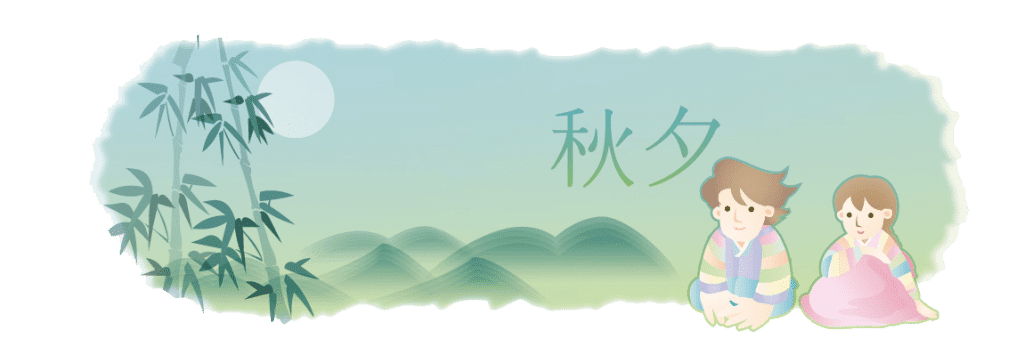
How did Chuseok start? – Chuseok History
According to many historians, Chuseok dates back nearly two thousand years ago. Silla’s third king, Yuri (24-57), is credited with beginning Chuseok as a competitive festival. Each team was split into groups of women and tasked with weaving silk over the course of a month — beginning on the 16th day of the 7th month and ending on the 14th day of the 8th month. During this period each team weaved as much cloth as they could. The team that made the most cloth was declared the winner and was treated to a great feast of food and alcohol provided by the losing team.

Chuseok Traditions – What happens during Chuseok?
There are lots of traditions that take place during Chuseok. Some of which are fun, and others are profoundly sentimental, and all of them devoted to the family. One of the main Chuseok traditions is for the whole family to move to the most senior family member’s house for the celebration. Therefore, most people in the country go back to their grandparents during this fest.
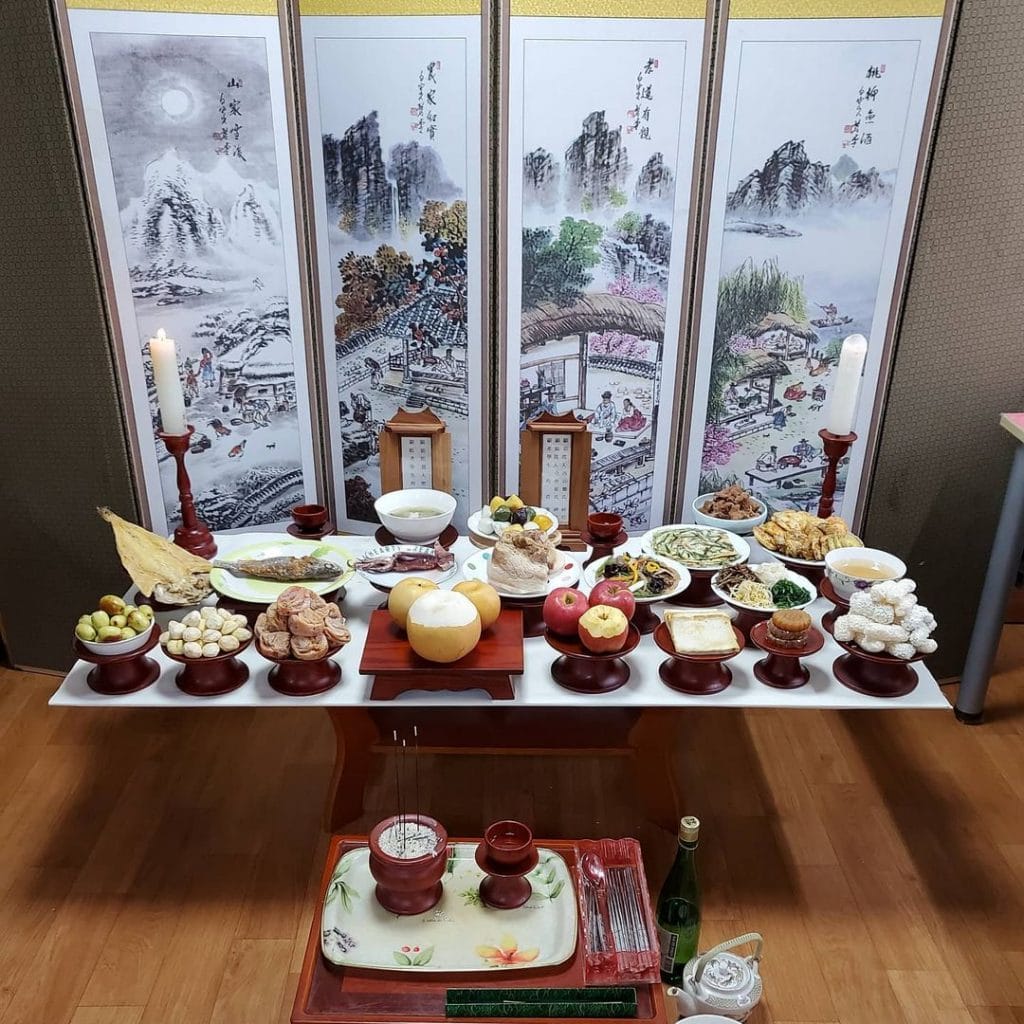
Charye – 차례
It translates to ‘Memorial or Ancestors’, and it takes place on the first day of the festival. Just like the name suggests, the family members keep a memorial service for their ancestors. Where all the family members bow down, pay respects to their ancestors and offer their gratitude for the harvest also known as Chuseok bowing. Charye customs involve the preparation of traditional foods to offer to generations of ancestors.

Beolcho – 벌초
Beolcho is a heartfelt custom where the family goes to the ancestors’ graves and clean them by plucking out any weeds and dusting off any dirt that might have been accumulated. If weeds surround the graves, Then it is considered an unlucky sign and also regarded as shame for the descendants
Beolcho takes place a little before the main festival day as it is important for the families that the graves of their ancestors are free of any dirt or debris on Chuseok.

Exchanging Gifts
While paying homage to the ancestors is the main idea behind Chuseok, giving gifts is a symbol of showing love to the people that are there with us. Many Koreans are strict to the traditions and only celebrate the deceased during this festival while some have taken up to modern ways and brought in the custom of gift giving to celebrate the living ones.
Initially people gifted each other necessities like soaps, condiments, vegetables, fruits, mushrooms and oil. As years passed by people started giving each other cosmetics and hygiene products. Today there are far more options for gifting.
Popular Chuseok gifts are electronics, skincare products and cash. But however, Koreans prefer natural ingredients more and since food is such an integral part of Chuseok, edible gifts are the best kind of gifts. You can choose from fish sets, beef sets, oil sets, tea sets, combo sets and more. The options are endless.
These sets are available in all markets during Chuseok and are very easily available
Chuseok Foods
The modern day Chuseok is celebrated with a variety of foods from everywhere. But there are some traditional dishes that are made in every household during this festival. These food items have been passed down since generations and are an integral part of Chuseok.
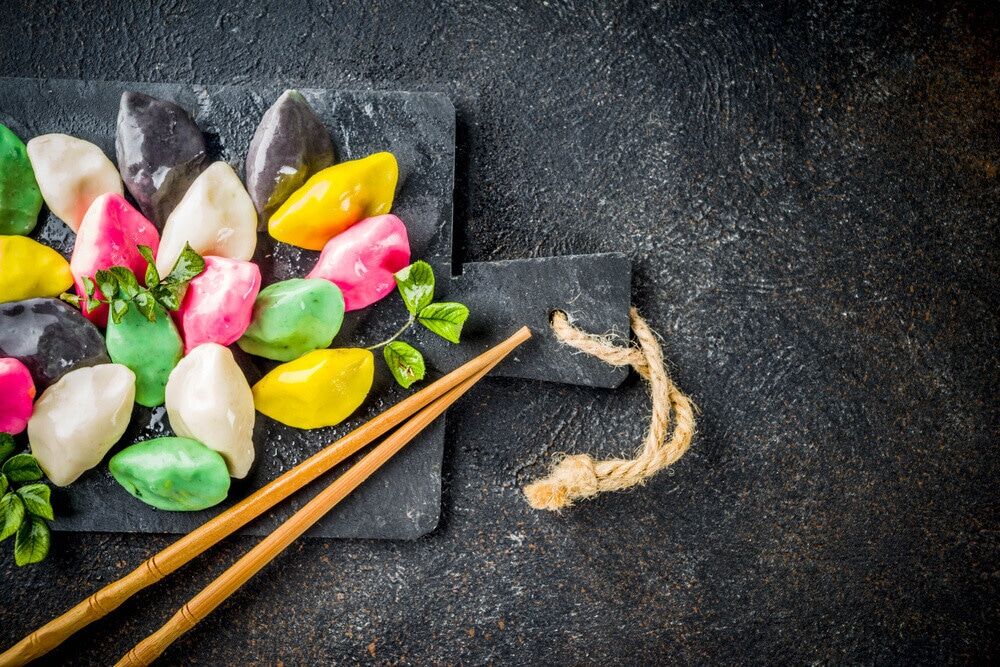
Songpyeon – 송편
Songpeyon is a type of rice cake made made from the newly harvested crops. Powdered rice is filled with various kinds of beans, sesame seeds and chestnuts. These are then shaped into moons to represent the Lunar moon. Steamed with pine needles, this dish is filled with flavour and it is believed that if the Songpeyon is beautiful and tasty, the household will have beautiful children and successful marriages.
The reason Songpeyon got its shape as it is now is a different story altogether. The Songpeyon is always in the shape of a half moon. According to legend, during the reign of the King Uija (641-660), There was a prophecy that predicted Baekje would fall down from power and Silla would rise to power. A turtle with strange markings on its back was found, It was later desiphered by the wise men of the kingdon that the message on the back of turtle said ‘Baejke is like a full moon and Silla is like a half moon’.
The meaning of the message was that a full moon cannot grow anymore and has to decrease in size every passing day while a half moon has much more potential to grow.
The prophecy came true and Silla defeated Baejke. From there on people of Korea believe that the half moon is a bringer of prosperity. Therefore all Songpeyons are made into shapes of the half moon.

Japche – 잡채
Japache is a simple stir-fried Ramen dish. Ramen is fried in sesame oil, choice of vegetables ( like mushrooms, onions, spinach, carrots ) and meat. This dish might be simple but is very popular in Korea during Chuseok and many varieties of the dish are available during the time.
Some of these varieties include Beef Japche, Mushroom Japche, Fish Japche. These dishes can be easily found in the markets and malls during the festival. While the base ingredient of the dish; Ramen, stays the same, modernization has brought many variations to the traditional recipe and these are enjoyed all over Korea.

Jeon – 전
Jeon are basically Korean pancakes made up of fish, eggs, sweet potato, flour and vegetables. Fried in pan with sesame oil and ate during dinnertime. Another one of the simple but extremely popular dish during Chuseok.
Other traditions during Chuseok
Apart from the sentimental traditions, there are plenty of fun traditions that the Koreans follow during Chuseok.
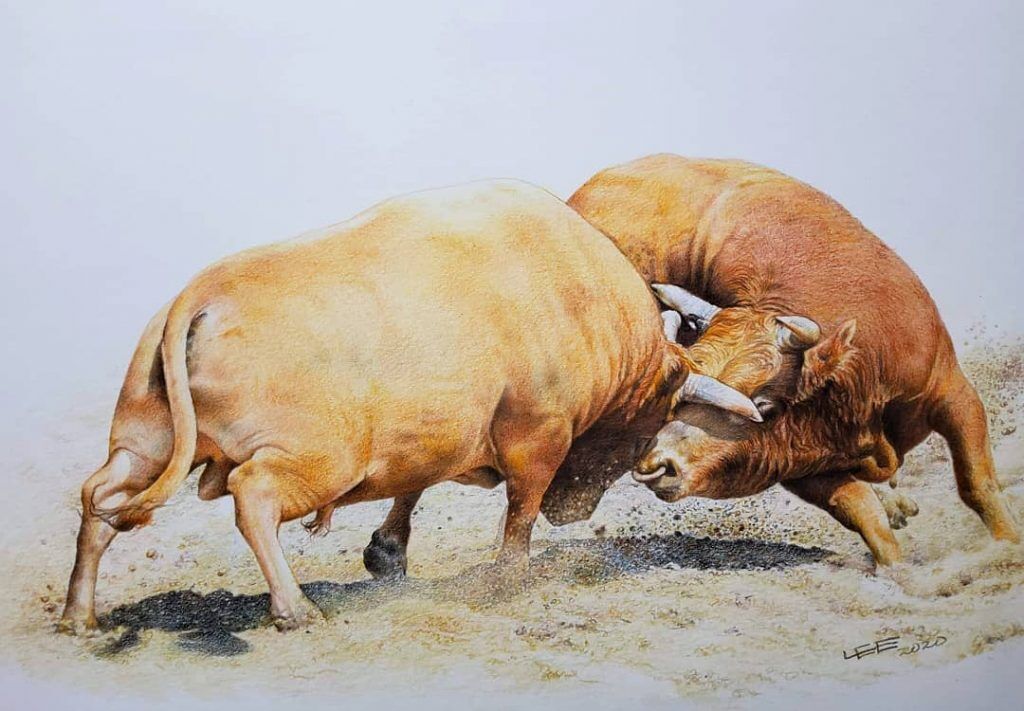
Sossaum (Bull Fighting) – 소싸움
One of the popular traditions of Korean Chusok is bullfighting. While a bullfighting competition sounds dangerous, it is nothing like bullfights in other countries. This fight is a competition between the two trainers on who trained their bull better. The bulls will lock heads and head-butt each other till one of them surrenders.
This takes place in a large stadium that attracts around 5,00,000 or more people to watch. If you are eager to celebrate Chusek the traditional way, grab a seat at the Sossaum stadium. Apart from the live audience, it’s a tradition for the whole family to sit together and watch the fight on TV from their homes.
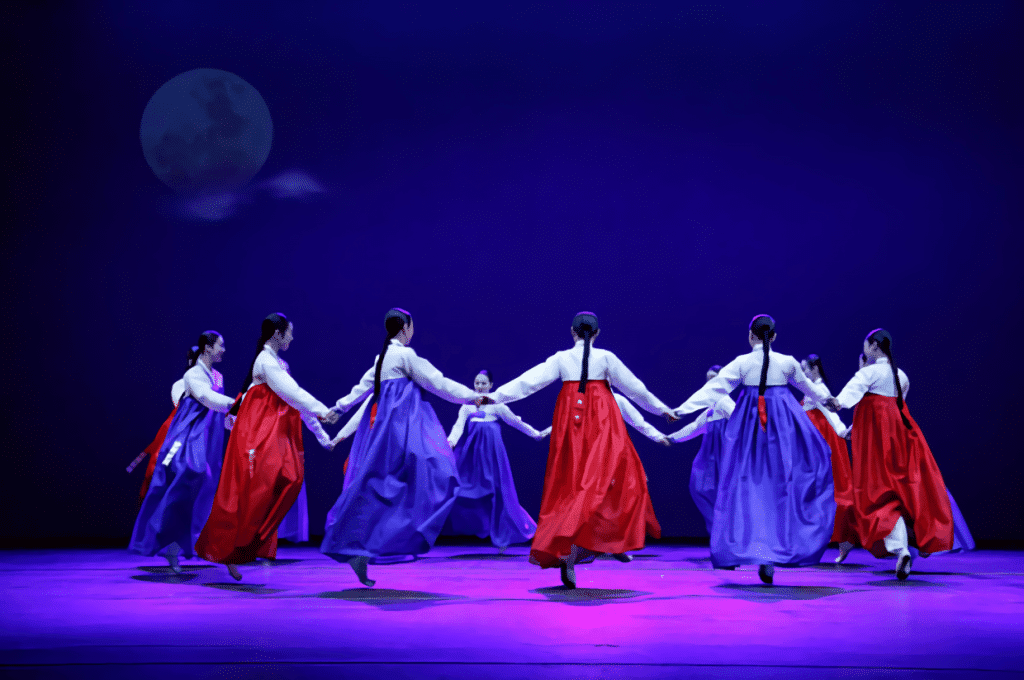
Ganggangsullae 강강술래
Ganggansullae is a sort of prayer ritual where women dance together in a circle with their hands linked, praying for a good harvest. Its a tradition where they dance and sing in a clockwise motion. As the dance progresses and time passes, the speed of the dance increases. This is a vital custom and is passed down through generations. Since this dance is mostly performed by young and unmarried women, little girls are taught the dance by their family or their school early on. The moves are easy, and the song is repeated after a lead singer. The ritual takes place under the light of a bright full moon and sometimes even goes on till dawn.

Ssireum 씨름
Another important tradition is a wrestling competition. Men would wrestle each other on a sandy surface and tackle their opponent to the ground to win. The interesting thing about this wrestling is that the two opponents have to wrestle each other by holding on to their opponent’s belt called the ‘Satba’. Satba comes in 2, Red and blue colors. The person who forces the opponent to touch the ground with any part of his body at knee level or higher is considered a winner.
While Ssireum and Sumo wrestling might seem like the same thing, they differ in rules. In Sumo wrestling, one wins by pushing their opponent out of the ring they are playing in. In Ssireum, one wins if any upper body part (above the knee) of their opponent touches the ground. While bulky wrestlers play sumo wrestling, you can find muscular men wrestling it out in Ssireum.
Everyone gathers around the TV after dinner and watches this sport on Chuseok. The winner of the competition gets Rice and a Bull.
Foreigners and Chuseok
Chuseok is a completely family-oriented festival; hence Foreigners cannot have much fun or traditional experiences if they don’t already have friends or family in Korea. As everyone is going back to their hometowns, Seoul is mostly closed and empty too. But here are some ways in which a foreigner can have fun on Chusek
Greetings for Chuseok
Learn the Chuseok Greeting. There is no better way of wishing someone than in their language. Using it would also give you a taste of Korean culture. Here’s how you say it .
Have a good Chuseok
Chuseog Jal Bonaeseyo
추석 잘 보내세요!
- You can try authentic Chuseok foods like Songpeyon, Japche, and more. During this time, you are very likely to find these dishes anywhere. Not only would it raise the spirit of Chuseok in you, but it would also take your taste buds on a ride.
- Visit the graveyard and pay your respects to the people who are not there with us. They might not be your family, but praying for someone never goes in vain, and that is the main point of Chuseok.
- Grab a seat at the stadium to watch Ssireum or Sossaum live.
- You can go sightseeing and roam around like a Korean because the roads would be empty for the festival, and you would have more time and space to enjoy Korea.
- Cultural sites and villages in Korea host special Chuseok events for guests. You could go there if you want a true Chuseok experience and do not have friends or family in Korea.
Namsangol Hanok Village is a wonderful place to visit during Chuseok. From traditional Korean houses to ancient rituals, they make the Chuseok experience amazing for Foreigners. One can take part in folk dances, watch music performances and have authentic Chuseok cuisine.
Another amazing place to visit is the National Museum of Korea. It is the largest museum in Korea. On Chuseok, they hold many traditional events and activities. Visiting the museum during the mid-autumn festival would give you a taste of Korean culture and a vast knowledge of Korean history.
It doesn’t matter if you are Korean or not. This festival gives out messages of love, respect, and gratitude, and we have a lot to learn from it. Chuseok will give you the utmost happiness and pride for your family. With the tastiest cuisines to mind-blowing games, this is a never-miss-out thing that you should experience at least once in your lifetime.
Korean Thanksgiving Day 2020
The Korean Thanksgiving Day 2020 was a tough time for the South Koreans because of the COVID-19 outbreak. People were advised to stay at home and gatherings were restricted with a limited number of people. People could not follow their chuseok traditions which were tough for them but for safety reasons it was needed for the Korean Thanksgiving Day 2020. The chuseok date does vary every year. Even though the festival takes place every year from September-October, the dates fluctuate. The chuseok date for the year 2022 is September 10th. The Korean harvest festival is a time of mass celebration and as stated by the historic records, it involves worshipping the moon goddess.
True, the Korean harvest festival is celebrated to hope for a good year and be thankful for the bountiful harvest but there are a few legends that tell how the festival started in the first place. Dating back hundreds of years, these legends are remembered each year and conveyed to each emerging generation.
Legends of the Mid-Autumn Festival
Different legends tell us the cause of the mid autumn festival korean, there is a tale recorded in Samyuk Sagi, two princesses who lived in the time of King Yuri of the Shilla dynasty. At the time, the capital city was divided into two and given each to the princesses. There was a weaving competition held and at the end of the competition in the 8th month, the winner was treated with alcohol and rice followed by a celebration with dance and games. This is one of the legends that tell the start of Chuseok in Korea.
Since the mid-autumn festival is celebrated in many Asian countries, China is one of the countries having some similar legends too. In China, the Korean moon rabbit is known as the Jade rabbit. It is believed in China that the jade rabbit can be seen pounding something on the moon on the night of the mid-autumn festival. Hence, it is also called the full moon rabbit. The rabbit in moon story came into existence when the king from centuries ago put on a disguise and went to test his subjects. On his trail he came upon three animals, one of them was a rabbit. The king requested them for some food and having no food to offer to the king in disguise, the rabbit jumped in a fire to offer itself as food to the king. Impressed by the bravado of the rabbit, the king blessed the rabbit by sending him to the moon and making him immortal. Such is the tale of the full moon rabbit.
People Also Ask
Do Koreans celebrate Chuseok?
Koreans celebrate Chuseok, which is a harvest festival that celebrates the end of the summer harvest. It is also a time for families to get together and give thanks for the bountiful harvest.
Why is Chuseok important?
Chuseok is an important Korean holiday that celebrates the harvest. It is a time for families to get together, give thanks for the bounty of the harvest, and enjoy traditional Korean foods.
Is Chuseok Korean New Year?
No, Chuseok is not Korean New Year. Chuseok is a harvest festival that is celebrated on the 15th day of the 8th month of the lunar calendar.
What is Thanksgiving in Korea?
Thanksgiving in Korea is a time to celebrate the harvest and give thanks for the year’s bounty. Families and friends gather together to enjoy a feast of traditional Korean dishes, such as kimchi (fermented cabbage), bibimbap (rice and vegetables), and bulgogi (marinated beef). The holiday is also a time for exchanging gifts and goodwill.
Why do Koreans have Thanksgiving?
Koreans have Thanksgiving to give thanks to their ancestors for their good harvest.
Do Korean Americans celebrate Thanksgiving?
Yes, many Korean Americans celebrate Thanksgiving.
Is Chuseok and moon festival the same?
While both Chuseok and the Moon Festival are holidays that involve celebrating the harvest, they are not the same holiday. Chuseok is a Korean holiday while the Moon Festival is a Chinese holiday.
What is Korean Thanksgiving called?
Korean Thanksgiving is called Chuseok.
Is Chuseok a religious holiday?
No, Chuseok is not a religious holiday.
How long is Chuseok holiday?
The Chuseok holiday is three days long.
What happens during Chuseok?
During Chuseok, people celebrate by spending time with their families, eating traditional holiday foods, and playing games.
Is Chuseok celebrated every year?
Chuseok is celebrated every year on the 15th day of the 8th month of the lunar calendar.
Do you bow on Chuseok?
There is no specific tradition of bowing on Chuseok, but it is generally considered polite to bow to elders and people in positions of authority.
Today, we will discuss one of the most important Korean holidays in Korea–Chuseok, or the Korean version of Thanksgiving. We will be offering detailed information about what you are expected to do during the holidays, as well as the activities that take place during the holidays.
- Chuseok Holiday: What is Chuseok and When Is It?
- Korean Traditional Holiday: History of Chuseok
- Chuseok Activities: Are There Any Korean Traditional Games?
- Traditional Chuseok Foods: What do you eat on Chuseok?
- Chuseok Greetings: Phrases You Need to Know
- Activities for Foreigners During Chuseok
- How KoreanClass101 Can Help You
1. Chuseok Holiday: What is Chuseok and When Is It?
1- What is Chuseok and What Do You Do on Chuseok?
추석 [Chuseok], also known as the Korean Thanksgiving holidays, is one of the most important cultural holidays in Korea, along with 설날 [Seollal; New Year’s Day], in South Korea. It is celebrated on the 15th day(full moon) of the 8th month in the lunar calendar.
Traditionally, Koreans used to wear traditional clothes called 한복 [Hanbok] when visiting their parents and extended family during the holidays. Women usually prepared the table filled with food for the family’s ancestors. It may sound fun since everyone visits their home to meet their family, but preparing the food is still not an easy task for Korean women as there are many different dishes to prepare, such as rice, soup, rice cakes, fruits, and various other dishes, traditional drinks, and desserts.
After the meal preparation and ancestral worship, the family will gather to have big meals together. Some Korean families will visit their ancestor’s graveyards located in the deep mountains, while others engage in family activities together. We’ll provide more details below.
2- So When is Chuseok?
Chuseok fell on the 13th of September in 2019, but the holiday period actually lasts for three or more. The date of Chuseok is different every year as it is based on the lunar calendar, so it’s mandatory to check the exact date and plan the traveling in advance. This is because most Koreans will return to their hometowns, resulting in a lack of train and airplane tickets and major traffic jams.
Here are the dates of Chuseok for the next 10 years:
- 2019: 9월 13일 [guwol sipsamil] – September 13, 2019
- 2020: 10월 1일 [siwol iril] – October 1, 2020
- 2021: 9월 21일 [guwol isibiril] – September 21, 2021
- 2022: 9월 10일 [guwol sibil] – September 10, 2022
- 2023: 9월 29일 [guwol isipguil] – September 29, 2023
- 2024: 9월 17일 [guwol sipchiril] – September 17, 2024
- 2025: 10월 6일 [siwol yugil] – October 6, 2025
- 2026: 9월 25일 [guwol isiboil] – September 25, 2026
- 2027: 9월 15일 [guwol iboil] – September 15, 2027
- 2028: 10월 3일 [siwol samil] – October 3, 2028
2. Korean Traditional Holiday: History of Chuseok
The origin of the Chuseok holidays isn’t clear. From what little that we know, Chuseok originates back to nearly 2,000 years ago, when the third king of the Silla dynasty, King Yuri (24-57) supposedly started the chuseok holidays as a competitive festival. Legend states that the women in the kingdom were put into different groups for a certain amount of time. During this time, each team weaved as much cloth as they could, and the winning team was treated to a feast of food.
3. Chuseok Activities: Are There Any Korean Traditional Games?
There are many activities that you can enjoy during Chuseok.
1- 강강술래 [Ganggangsullae] – 5,000-year-old Korean Traditional Dance
강강술래 [Ganggangsullae] is a Korean traditional dance that is performed by women only at night.
- Ganggangsullae Video
- Ganggangsullae Images
The women stand in circle and hold each other’s hand as they move around in a clockwise direction. There is no music accompanying the dance; one woman sings, while the other women repeat 강강술래 [ganggangsullae] over and over. The songs performed during the dance tell stories about everyday life in Korea.
2- 윷놀이 [Yunnori] – Traditional Board Game Played in Korea
윷놀이 [Yunnori] is a traditional Korean board game. Usually, the game is played by two teams or more. It is similar to a board game where you throw one or two dices to move forward. Instead of a dice, there are 윷[yut] sticks, which are 4 sticks. Also, when you throw these Yut sticks, each combination has its name. For example:
- 도 [do]: One stick over and three sticks up; take a step forward
- 개 [gae]: Two sticks up and two sticks over; take two steps forward
- 걸 [geol]: One stick up and three sticks over; take three steps forward
- 윷 [yut]: All sticks over; take 4 steps forward
- 모 [mo]: All sticks up; take 5 steps forward
If you are not sure how the combination works, check out this image.
- More information about game rule
- Yut Video
- Yut Images
Also, when sticks result in either 윷 [yut] or 모 [mo], the play gets another chance of throwing the sticks.
3- 씨름 [ssireum]- Traditional Korean Wrestling
씨름 [ssireum] also known as Korean wrestling is a traditional national sport of Korea since the fourth century. Ssireum was originated back in the Goguryeo period.
- Ssireum Video
- Ssireum Images
In the 20th century, 씨름[ssireum] gained popularity and quickly became a nationally televised sport in South Korea. People would gather around to watch the 씨름[ssireum] championships. However, in recent days, 씨름[ssireum] has lost its popularity and is rarely shown on TV.
4- 줄다리기 [juldarigi] – Korean Traditional Tug of War
줄다리기 [juldarigi] is the Korean version of tug of war.
- Juldarigi Video
- Juldarigi Images
The concept is similar to the Western version. Participants use a huge rice-straw rope which is pulled at by two teams. The number of rice-straw ropes and the rules may vary depending on the region.
5- 거북놀이 [geobungnori] – Turtle Play
거북놀이 [geobungnori], direct translation being ‘Turtle Play’, is a play which is performed to drive away negative spirits and ghosts, and wish for good health and long life.
- Geobungnori Video
- Geobungnori Images
It is usually performed in the 경기도 [Gyeonggi Province] and 충청도 [Chungcheong Province] regions during the Chuseok holidays.
4. Traditional Chuseok Foods: What do you eat on Chuseok?
1- Exchanging Gifts: Huge Variety of Chuseok Gifts
Gift-giving is a new tradition. Koreans show their appreciation for the people in their lives by giving others gifts for Chuseok–this can be to family, friends, coworkers, and bosses.
At a supermarket, you will be able to see a variety of Chuseok gift sets, such as Spam, high-quality cuts of beef, baskets of beautifully wrapped fresh fruits, and so on. Between business acquaintances, Koreans usually exchange sets of Korean traditional sweets or wines.
One thing to note is 김영란법 [Kim Young-ran Act; The Improper Solicitation and Graft Act], so there is a limit to how much money you can spend on gifts. This law does not apply to friends or family members but does for business acquaintances, so please watch out for it if you are planning to exchange Chuseok gifts.
2- List of Traditional Korean Chuseok Food that You Can Eat
On Chuseok, there is some food that you can only eat during the holidays–it is similar to Seollal, when Koreans eat 떡국 [tteokguk; rice cake soup] to celebrate the New Year. During Chuseok, Songpyeon, a type of sweet rice cake, is the signature food. It is relatively easy to make and delicious. Now let’s see a list of Chuseok foods:
1. 송편 [Songpyeon] – Korean Rice Cakes with Honey
송편 [songpyeon] is a signature Chuseok food which is made of glutinous rice. Songpyeon is half-moon shaped rice cakes that contain sweet ingredients such as honey, chestnut paste or red bean paste inside. Half-moon shaped Songpyeon is the original, but these days, there are various different shapes of Songpyeons available.
2. 전 [Jeon] – Traditional Korean-style Pancake
전 [jeon] is a traditional Korean-style pancake. You can eat it as a main dish, side dish, or even as an appetizer or snack. The ingredients you put inside is completely up to you. You can add scallions, kimchi or various vegetables and seafood.
3. 잡채 [Japchae] – Stir-fried glass noodles with various vegetables
잡채 [japchae] is savory stir-fried glass noodles with meat and various vegetables such as carrots, mushrooms, and onions, seasoned with soy sauce and sesame oil. Japchae is a traditional Korean food that is served on special occasions such as weddings, birthdays and holidays.
4. 제사상 음식 [Jesasang eumsik] – Variety of Foods for Ancestral Rites Table
The main activity of Chuseok is 제사 [jesa], which is a ceremony practiced in South Korea. Women prepare meals for ancestors and you will be able to eat all the dishes after the worship. Variety of dishes are placed on a table. For example: fruits and vegetables such as 감 [gam; persimmon], 배 [bae; Asian pear], 사과 [sagwa; apple], 배추 [baechu; Napa cabbage],밤 [bam; chestnut], 곶감 [gotgam; Dried Persimmon] and other dishes such as 생선 [saengseon; fish], 나물 [namul; seasoned vegetables], 전 [jeon; Korean traditional pancake], 한과 [Hangwa; Korean traditional sweets] and many more. Note that the preparation of dishes vary slightly depending on a family, as some families add 바나나 [banana] or other foods that are not normally being served during Chuseok, but simply survived because one of the ancestors loved them. To give you an idea of how dishes are places, here are some pictures.
5. Chuseok Greetings: Phrases You Need to Know
Knowing how to say ‘Happy Chuseok’ in Korea is important since people exchange many Chuseok greetings to each other in Korea.
1- 즐거운 한가위 보내세요.
- Jeulgeoun hangawi bonaeseyo.
- I hope you have a Happy Thanksgiving.
즐거운[jeulgeoun] – pleasant
한가위 [hangawi] – Korean Thanksgiving Day, aka 추석 [Chuseok]
2- 좋은일만 가득하세요.
- Joeunilman gadeukaseyo.
- I wish you all the best.
좋은일 [joeunil] – good things
가득하다 [gadeukada] – full
3- 즐겁고 행복한 추석 보내시길 바랍니다.
- Jeulgeopgo haengbokan chuseok bonaesigil baramnida.
- We wish you a wonderful and happy Chuseok.
행복한 [haengbokan] – happy
추석 [Chuseok] – Korean Thanksgiving
바랍니다 [baramnida] – wish
4- 추석 때 어디 갔어요?
- Chuseok ttae eodi gasseoyo?
- Where did you go during Chuseok?
~때 [~ttae] – the moment
어디 갔어요? [eodi gasseoyo?] – where did you go?
5- 추석 때 무엇을 했나요?
- Chuseok ttae mueoseul haennayo?
- What did you do on Chuseok?
~때 [~ttae] – the moment
무엇을 했나요? [mueoseul haennayo?] – what did you do?
6- ~에 갔었습니다.
- ~e gasseotseumnida.
- I went to ~
Example:
추석 때 서울에 갔었습니다.
Chuseok ttae seoure gasseotseumnida.
I went to Seoul during Chuseok.
6. Activities for Foreigners During Chuseok
For travelers or foreigners living in Korea, Chuseok can be lonely since everyone including friends will be away to celebrate Chuseok. The good news is there are many events only for foreigners during this time–for example, 캐리비안베이 [Caribbean Bay] at Everland offers special discounts for foreigners, so that they can enjoy the indoor and outdoor water park.
To receive a discount, visit their website and download a special discount coupon during the Chuseok event. Caribbean Bay is one of the most crowded amusement parks in Korea, but if you have a privilege to enjoy a spacious place with fewer people.
Also, many other touristic areas offer special events during Chuseok, so be sure to check out their events to enjoy them too.
7. How KoreanClass101 Can Help You
You may want to check out our free lessons such as Korean Thanksgiving Day, a culture class about Chuseok and 7 must-know vocabularies for Chuseok and many more. We also have more Chuseok related Korean articles such as here and top 10 Korean Special event :Chuseok .
Feel free to visit KoreanClass101 for free vocabulary lists, pronunciation practices and also a forum where you can ask any questions about Korea including grammar, pronunciation, cultures and so on.
We hope you found this blog informative and good luck with studying Korean!
| Chuseok | |
|---|---|

Songpyeon, a type of tteok to celebrate Chuseok. |
|
| Official name | Chuseok (추석, 秋夕) |
| Also called | Hangawi, Jungchujeol |
| Observed by | Koreans |
| Type | Cultural, religious (Buddhist, Confucian, Muist) |
| Significance | Celebrates the harvest |
| Observances | Visit to their family’s home town, ancestor worship, harvest feasts with songpyeon and rice wines |
| Begins | 14th day of the 8th lunar month |
| Ends | 16th day of the 8th lunar month |
| Date | 15th day of the 8th month of the Chinese lunar calendar |
| 2022 date | 9 September – 11 September |
| 2023 date | 28 September – 30 September |
| 2024 date | 6 September – 8 September |
| 2025 date | 16 September — 18 September |
| Frequency | Annual |
| Related to | Mid-Autumn Festival (in China) Tsukimi (in Japan) Tết Trung Thu (in Vietnam) Uposatha of Ashvini/Krittika (similar festivals that generally occur on the same day in Cambodia, India, Sri Lanka, Myanmar, Laos, and Thailand ) |
| Korean name | |
| Hangul |
추석 |
|---|---|
| Hanja |
秋夕 |
| Revised Romanization | chuseok |
| McCune–Reischauer | ch’usŏk |
| IPA | [tɕʰusʌk̚] |
| Original Korean name | |
| Hangul |
한가위 |
| Revised Romanization | han-gawi |
| McCune–Reischauer | han’gawi |
| IPA | [hɐnɡɐɥi] |
Chuseok (Korean: 추석; Hanja: 秋夕; [tɕʰu.sʌk̚], literally «autumn evening»), also known as Hangawi (Hangul: 한가위; [han.ɡa.ɥi]; from archaic Korean for «the great middle (of autumn)»), is a major mid-autumn harvest festival and a three-day holiday in South Korea celebrated on the 15th day of the 8th month of the lunar calendar on the full moon. In North Korea, they only celebrate for the day of chuseok.[1] Like many other harvest festivals around the world, it is held around the autumn equinox, i.e. at the very end of summer or in early autumn. It is the biggest traditional holiday in South Korea.
As a celebration of the good harvest, Koreans visit their ancestral hometowns and share a feast of Korean traditional food such as songpyeon (Korean: 송편; Hanja: 松䭏), yakgwa, fruits like Asian pear and hallabong, and rice wines such as sindoju (Korean: 신도주; Hanja: 新稻酒). and dongdongju (Korean: 동동주; Hanja: 浮蟻酒). There are two major traditions related to Chuseok: Charye (Korean: 차례; Hanja: 茶禮, ancestor memorial services at home, also known as Jesa), and Seongmyo (Korean: 성묘; Hanja: 省墓, family visit to the ancestral graves), which is usually accompanied by Beolcho (Korean: 벌초; Hanja: 伐草, tidying graves, removing weeds around them).[2] Another major custom is to prepare the family’s ancestors their favorite meals as an offering.
Origins[edit]
According to popular belief, Chuseok originates from gabae (Korean: 가배; Hanja: 嘉俳·嘉排). Gabae started during the reign of the third king of the kingdom of Silla (57 BC — 935 AD), when it was a month-long weaving contest between two teams.[3][4] On the day of Gabae, the team that had woven more cloth won and would be treated to a feast by the losing team. It is believed that weaving competitions, archery competitions, and martial arts demonstrations were held as part of the festivities.[5]
Many scholars also believe Chuseok may originate from ancient shamanistic celebrations of the harvest moon.[4] New harvests are offered to local deities and ancestors, which means Chuseok may have originated as a worship ritual.[6] In some areas, if there is no harvest, worship rituals are postponed, or in areas with no annual harvest, Chuseok is not celebrated.[citation needed]
Traditional customs[edit]
Another table with many traditional food offerings on it
In contemporary South Korea, on Chuseok, masses of people travel from large cities to their hometowns to pay respect to the spirits of their ancestors.[7] Chuseok celebrates the bountiful harvest and strives for the next year to be better than the last. People perform ancestral worship rituals early in the morning. Then, they visit the tombs of their immediate ancestors to trim plants, clean the area around the tomb, and offer food, drink, and crops to their ancestors.[7] The rest of the day is spent playing folk games and bonding with the family members. South Koreans consider autumn the best season of the year due to clear skies, cool winds, and it is the perfect harvesting weather. Harvest crops are attributed to the blessing of ancestors. Chuseok is commonly incorrectly translated as «Korean Thanksgiving» in American English despite the holidays being vastly different in origin and celebration.[8] Although most South Koreans visit their families and ancestral homes, there are festivities held at the National Folk Museum of Korea. Many places are closed during this national holiday, including banks, schools, post offices, governmental departments, and stores. Airline tickets to South Korea around the festival are usually sold out three months in advance and roads and hotels are overcrowded.[9]
Charye[edit]
Charye is one of the ancestral memorial rites celebrated during Chuseok, symbolizing the abundance of the harvest season and honoring ancestors and past generations.[10] The rite involves the gathering of families in holding a memorial service for their ancestors through the harvesting, preparation and presentation of special foods as offerings.[11] Preparation for the food usually takes hours and many families start the cooking process early in the morning. The rite embodies the traditional view of spiritual life beyond physical death, respecting the spirits of the afterlife that now also serve to protect their descendants. The foods offered vary across provinces depending on what is available, but commonly feature freshly harvested rice, rice cakes (songpyeon) and fresh meat, fruit and vegetables.[12] The arrangement of the foods of Charye on the table is also notable: traditionally rice and soup are placed on the north and fruits and vegetables are placed on the south; meat dishes are served on the west and in the middle, and rice cake and some drinks such as makgeolli or soju are placed on the east. These details can vary across regions.[13]
Hanbok[edit]
The hanbok (in South Korea) or Choson-ot (in North Korea) is the traditional dress that the Korean people wear on special holidays and formal and semi-formal occasions, such as Chuseok, Lunar New Year, and weddings. The term «hanbok» literally means «Korean clothing.» The basic structure of the hanbok consists of the jeogori jacket, baji pants, chima skirt, and the po coat. The design of the hanbok remains unchanged to this day and is designed in a variety of colors.[14]
Food[edit]
Songpyeon[edit]
One of the major foods prepared and eaten during the Chuseok holiday is songpyeon (Hangul: 송편; 松餠), a Korean traditional rice cake[7] made with ingredients such as sesame seeds, black beans, mung beans, cinnamon, pine nut, walnut, chestnut, jujube, and honey.
When making songpyeon, steaming them over a layer of pine-needles is critical. The word song in songpyeon means a pine tree in Korean. The pine needles not only contribute to songpyeon’s aromatic fragrance, but also its beauty and taste.[15][16]
Songpyeon is also significant because of the meaning contained in its shape. However, some songpyeon are shaped like a ball. Songpyeon’s rice skin itself resembles the shape of a full moon, but once it wraps the stuffing, its shape resembles the half-moon. Since the Three Kingdoms era in Korean history, a Korean legend stated that these two shapes ruled the destinies of the two greatest rival kingdoms, Baekje and Silla. During the era of King Uija of Baekje, an encrypted phrase, «Baekje is full-moon and Silla is half-moon» was found on a turtle’s back and it predicted the fall of the Baekje and the rise of the Silla. The prophecy came true when Silla defeated Baekje. Ever since Koreans have believed a half-moon shape is an indicator of a bright future or victory.[16] Therefore, during Chuseok, families gather together and eat half-moon-shaped Songpyeon under the full moon, wishing for a brighter future.[17] There’s a belief that if a single woman makes a pretty songpyeon, she will find a great husband, and if a pregnant woman makes a pretty songpyeon, she will have a pretty daughter.[18]
Hangwa[edit]
Another popular Korean traditional food that people eat during Chuseok is hangwa. It is a general term to categorize sweet foods made with tteok, meaning rice cake. It is an artistic food decorated with natural colors and textured with patterns. Hangwa, also known as Hang, is made with rice flour, honey, fruit, and roots. People use edible natural ingredients to express various colors, flavours, and tastes. Because of its decoration and nutrition, Koreans eat hang not only during Chuseok, but also for special events, for instance, weddings, birthday parties, and marriages.[19]
The most famous types of hangwa are yakgwa, yugwa, and dasik. Yakgwa is a sweet honey cookie which is made of fried rice flour dough ball and yugwa is a fried cookie consisting of glutinous rice mixed with honey water, and cheongju (rice wine). Dasik is a tea cake that people enjoy with tea.[20]
Baekju[edit]
A major element of Chuseok is alcoholic drinks. Liquor drunk on Chuseok is called baekju (백주, 白酒, literally «white wine») and nicknamed sindoju (신도주, 新稻酒, literally «new rice liquor») as it is made of freshly harvested rice.[21][22]
Kooksoondang, a maker of Korean traditional liquors, restored «Yihwaju», rice wine from the Goryeo era (918–1392), and «Songjeolju» that has been widely enjoyed by Joseon (1392–1910) aristocrats. Its «Jamyang Baekseju» package comprises a variety of liquors ― Jayang Baekseju, Jang Baekseju, Baekokju ― that are claimed to enhance men’s stamina.[23]
Adults say that if you drink the alcoholic beverage which the ancestors have drunk; there will be nothing you’ll be scared of.[citation needed]
Others[edit]
Other foods commonly prepared are japchae, bulgogi, an assortment of Korean pancakes also known as jeon, saengseon (fried fish), tteokguk (rice cake soup), and fruits.
Gifts[edit]
History of Chuseok gifts[edit]
The Korean people started sharing daily necessities, such as sugar, soap or condiments, as Chuseok gifts in the 1960s. The gifts have changed since the Korean economy has developed. In the 1970s, Korean people had more options for Chuseok gifts; examples include cooking oil, toothpaste, instant coffee sets, cosmetics, television and rice cookers. People chose gift sets of fruit, meat and cosmetics in the 1980s. In the 1990s, people used gift vouchers for Chuseok. In the 21st century, more sophisticated gifts, such as sets of sweet desserts, spam, fruits, health supplements, and skincare have become the most popular options for Chuseok gifts.[24]
Types of Chuseok gifts and prices[edit]
Some extravagant gifts can be purchased: one kilogram of wild pine mushrooms, which are expensive because they cannot be artificially grown, (560,000 won) US$480.27 and red ginseng products (1.98 million won) US$1698.11. However, the most exorbitantly priced gift is six bottles of wine at Lotte Department Store for a staggering (33 million won) US$28,301.89.[25]
Chuseok gift sets are big business in Korea and prices are typically inflated around the holiday.[26]
Folk games[edit]
A variety of folk games are played on Chuseok to celebrate the coming of autumn and rich harvest. Sonori is a folk performance where Village folk dress themselves to resemble a cow or turtle and go from house to house along with a nongak band playing pungmul music. Other common folk games played on Chuseok are talchum (mask dance), board game called Yut Nori, (also known as Yunnori, Nyout, and Yout), archery, ssireum,(Korean wrestling), and juldarigi;[27] folk games vary by region.
Ssireum[edit]
Ssireum (Hangul: 씨름) is the most popular Korean sport played during Chuseok and contests are usually held during this holiday. Scholars have found evidence for ssireums dating back to the Goguryeo dynasty, Ssireum is assumed to have 5000 years of history. Two players wrestle each other while holding onto their opponent’s satba, a red and blue band. A player loses when his upper body touches the ground, and the winner becomes Cheonha Jangsa, Baekdu Jangsa, or Halla Jangsa, meaning «the most powerful». The winner gets a bull and 1 kg (2.2 lb) of rice as the prize.[28] Due to its popularity among both the young and the old, ssireum contests are held more frequently, not limited to important holidays.
Taekkyon[edit]
Taekkyon (Hangul: 태껸 or 택견) is one of the oldest traditional martial arts of Korea. Taekkyon was very popular during the Joseon period (1392-1897) where it was practised alongside Ssireum during festivities, including Chuseok. Though originally a hand-to-hand fighting method, plebs used a more tamed version alike to a kicking game. The practitioner uses the momentum of his opponent to knock him down through kicks, swipes and pushes.[29] Tournaments between players from different villages were carried out, starting with the children («Aegi Taekkyon») before finishing with the adults.
Taekkyon almost disappeared during the Japanese occupation (1910-1945) but is now considered a cultural heritage of Korea (1983) and a UNESCO intangible cultural item (2011).[30]
Ganggangsullae[edit]
The Ganggangsullae (Hangul: 강강술래) dance is a traditional folk dance performed under the full moon in the night of Chuseok.[31] Women wear Korean traditional dress, hanbok, make a big circle by holding hands, and sing a song while going around a circle. Its name, Ganggangsullae, came from the refrain repeated after each verse, and contains no actual meaning.
The dance originated in the southern coastal area of Korea. To watch a video clip of the Ganggangsullae dance, click here.[clarify]
For other folk games, they also play Neolttwigi (also known as the Korean plank), a traditional game played on a wooden board.[32]
Juldarigi[edit]
Juldarigi (Hangul: 줄다리기), or tug-of-war, was enjoyed by an entire village population. Two groups of people are divided into two teams representing the female and male forces of the natural world. The game is considered an agricultural rite to predict the results of the year’s farming. If the team representing the female concept won, it was thought the harvest that year would be rich.
Chicken Fight (Dak SSa Umm)[edit]
Korean people used to watch chicken fights (Hangul: 닭싸움), and learned how chickens fought; a game inspired by such was invented.
To play the game, people are separated into two balanced groups. One must bend his or her leg up and hold it bent with the knee poking out. The players must then attack each other with their bent knees, having to eliminate them by making their feet touch the ground; the last player holding up his or her knee wins.
The game is about strength, speed, and balance; to stay alive, one must display the capability of fighting back.[33]
Hwatu[edit]
Hwatu (Hangul: 화투, also known as Go-Stop or Godori) is composed of 48 cards including 12 kinds. The rules of the game and the term water originated from Tujeon.
It was formerly similar to Hanafuda, but was changed due to similarities with the latter. It went through a course that made it reduced by four base colors and thinner than before, spreading throughout to turn out goods on a mass-produced basis.[clarification needed]
Chuseok in North Korea[edit]
Since Chuseok is a traditional holiday that has been celebrated long before the division of Korea, people in North Korea also celebrate Chuseok. However, the ideology that divided Korea also caused some differences between the way that the holiday is celebrated in North Korea from the way it is celebrated in South Korea.[34] In fact, North Korea did not celebrate Chuseok and other traditional holidays until the mid-1980s.
While South Koreans celebrate Chuseok by visiting and spending time with family members, most North Koreans do not have any family gatherings for the holiday. Some, especially those in working classes, try to visit their ancestors’ gravesites during Chuseok. However, social and economic issues in North Korea have been preventing visits.[35] In addition, the extremely poor infrastructure of North Korea, especially in terms of public transportation, makes it almost impossible for people to visit grave sites and their families.[36] In contrast to the poor Songbun lower class North Koreans, middle and elite classes enjoy the holiday as they want, easily traveling wherever they want to go.[36]
See also[edit]
- Hansik, another Korean holiday for ancestral rituals
- List of Buddhist festivals
- List of harvest festivals
- List of festivals in South Korea
- Public holidays in South Korea
- List of Korean traditional festivals
Sources[edit]
- The Academy of Korean Studies, ed. (1991), «Chuseok», Encyclopedia of Korean People and Culture, Woongjin (in Korean)
- Farhadian, Charles E. (2007). Christian Worship Worldwide. Wm. Bm. Eerdmans Publishing. ISBN 978-0-8028-2853-8.
- Korea University Institute of Korean Culture, ed. (1982). «Social Life». Korean Heritage Overview. Vol. 1. Korea University.(in Korean)
- Aviles, K. (2011, September 10). Chuseok : A Festival With Two Faces. International Business Times. Retrieved December 4, 2012[37]
- Im, J. J. (2010, September 23). Daily NK — Welcome to Chuseok, North Korean Style. DailyNK. Retrieved December 4, 2012[38]
- Kim, K.-C. (2008). Ganggangsullae. UNESCO Multimedia Archives. Retrieved December 4, 2012[39]
- Korea.net. (2012, February 5). Chuseok, Korean Thanksgiving Day (English) — YouTube. YouTube. Retrieved December 4, 2012[40]
- Moon, S. H. (2008, September 16). Daily NK — New Chuseok Trends in North Korea. DailyNK. Retrieved December 4, 2012
- Official Korea Tourism. (2008, August 26). Official Site of Korea Tourism Org.: Chuseok: Full Moon Harvest Holiday, Korean Version of Thanksgiving Day. VisitKorea. Retrieved December 4, 2012
- The National Folklore Museum of Korea. (n.d.). Ancestral Memorial Rites — Charye | The National Folklore Museum of Korea. The National Folklore Museum of Korea. Retrieved December 5, 2012[41]
- TurtlePress (Martial Arts Video). (2009, May 1). SSireum Korean Wrestling History — YouTube. YouTube. Retrieved December 4, 2012[42]
- Yoo, K. H. (2009, October 5). Chuseok, North Korean Style. DailyNK. Retrieved December 4, 2012[43]
References[edit]
- ^ Passport to Korean Culture By Published by Korean Culture and Information Service Ministry of Culture, Sports and Tourism
- ^ «Chuseok (A Korean Thanksgiving)». chuseok.org. April 2021.
- ^ The Academy of Korean Studies, ed. (1991.) «Chuseok», Encyclopedia of Korean People and Culture, Woongjin (in Korean).
- ^ a b Farhadian, Charles E. (2007.) Christian Worship Worldwide. Wm. Bm. Eerdmans Publishing. ISBN 978-0-8028-2853-8.
- ^ , Yun, Sŏ-sŏk Yun. (2008.) Festive occasions: the customs in Korea, Ewha Womans University Press, Seoul. ISBN 978-8-9730-0781-3.
- ^ Korea University Institute of Korean Culture, ed. (1982.) «Social Life», Korean Heritage Overview, 1, Korea University (in Korean).
- ^ a b c «Traditional Korean Holiday, Chuseok». Imagine Your Korea. Retrieved 22 September 2016.
- ^ «Chuseok: Korean Thanksgiving Day». Asia Society. Retrieved 22 September 2016.
- ^ Lee, Cecilia Hae-Jin (2010). Frommer’s South Korea. Hoboken, N.J, Chichester: Wiley, John Wiley. pp. 21, 22, 25. ISBN 978-0470591543.
- ^ «Korean Ancestral Memorial Rites, Jerye. — South-Korea — korea4expats». Korea4expats.com.
- ^ «A time for families, food and festivities». Jejuweekly.com.
- ^ «Traditional Korean Holiday of Bountiful Harvest, Chuseok | Official Korea Tourism Organization». English.visitkorea.or.kr. Retrieved 2018-08-22.
- ^ «메세지 페이지». Nfm.go.kr.
- ^ «Chuseok Hanbok». Chuseok.org. 12 March 2022.
- ^ «Official Site of Korea Tourism Org.: Chuseok – Full Moon Harvest Holi…». Archived from the original on 21 February 2013.
- ^ a b «No Chuseok Without Songpyeon». English.chosun.com. Retrieved 27 December 2018.
- ^ «Official Site of Korea Tourism Org.: Chuseok – Full Moon Harvest Holi…». Archived from the original on 21 February 2013.
- ^ «What are the types of TTEOK 떡 (Rice Cakes) and their meanings?». Hyphe-Nated. Retrieved 9 September 2021.
- ^ «Hangwa –Korean Traditional Confectionaries Good for the Body and the Soul — INSIDE Koreabrand.net». www.koreabrand.net. Archived from the original on 18 January 2012. Retrieved 14 January 2022.
- ^ «Korea Tour Guide». English.visitKorea.or.kr. Retrieved 22 September 2016.
- ^ 임동권 (Im Dong-kwon) (1996). «Chuseok». 한국민족문화대백과사전 (Encyclopedia of Korean Culture) (in Korean). Retrieved 2021-08-18.
- ^ «Let’s Share the Happiness of Harvest on Chuseok». AgraFood. August 29, 2011. Archived from the original on 2016-12-20. Retrieved 2016-12-09.
- ^ «Chuseok, sharing the spirit of gratitude». Korea Herald. September 6, 2013. Retrieved 27 December 2018.
- ^ «한국을 대표하는 글로벌 방송! The World On Arirang!». Arirang.com. Retrieved 27 December 2018.
- ^ «Dollar : 네이버 통합검색». Archived from the original on 2021-08-20. Retrieved 2016-12-09.
- ^ «10 Ridiculously Priced Korean Chuseok Gift Sets — 10 Magazine Korea». 10mag.com. 23 September 2015.
- ^ «Chuseok Games». Chuseok.org. 13 March 2022.
- ^ What’s on Korea. (2001, July 28) Archived 2006-05-23 at the Wayback Machine
- ^ «the importance of Taekkyon in Korean traditional culture».
- ^ «Taekkyon entry on UNESCO’s world heritage list».
- ^ Seoul City. (2004, September 2) Archived 2013-04-19 at archive.today
- ^ «Festivals, events to delight on Chuseok holidays». Korea.net. Retrieved 22 September 2016.
- ^ «Wikispaces». Archived from the original on 2018-07-31.
- ^ «Chuseok— A Festival With Two Faces». International Business Times. 10 September 2011.
- ^ «Archived copy». Archived from the original on 2018-01-07. Retrieved 2018-12-27.
{{cite web}}: CS1 maint: archived copy as title (link) - ^ a b Jin, Im Jeong (23 September 2010). «Welcome to Chuseok, North Korean Style». Dailynk.com.
- ^ «Chuseok— A Festival With Two Faces». International Business Times. 10 September 2011. Retrieved 27 December 2018.
- ^ Jin, Im Jeong (23 September 2010). «Welcome to Chuseok, North Korean Style». Dailynk.com. Retrieved 27 December 2018.
- ^ Kwang-shik-CHA, Kim. «Ganggangsullae». Unesco.org. Retrieved 27 December 2018.
- ^ «Chuseok, Korean Thanksgiving Day (English)». YouTube. Retrieved 27 December 2018.
- ^ «메세지 페이지». Nfm.go.kr. Retrieved 27 December 2018.
- ^ «SSireum Korean Wrestling History». YouTube. Retrieved 27 December 2018.
- ^ Hee, Yoo Gwan (5 October 2009). «Chuseok, North Korean Style». Dailynk.com. Retrieved 27 December 2018.
External links[edit]
Media related to Chuseok at Wikimedia Commons
- Chuseok, Korean Thanksgiving Day on YouTube
- Chuseok, North Korean Thanksgiving Day on YouTube
| Chuseok | |
|---|---|

Songpyeon, a type of tteok to celebrate Chuseok. |
|
| Official name | Chuseok (추석, 秋夕) |
| Also called | Hangawi, Jungchujeol |
| Observed by | Koreans |
| Type | Cultural, religious (Buddhist, Confucian, Muist) |
| Significance | Celebrates the harvest |
| Observances | Visit to their family’s home town, ancestor worship, harvest feasts with songpyeon and rice wines |
| Begins | 14th day of the 8th lunar month |
| Ends | 16th day of the 8th lunar month |
| Date | 15th day of the 8th month of the Chinese lunar calendar |
| 2022 date | 9 September – 11 September |
| 2023 date | 28 September – 30 September |
| 2024 date | 6 September – 8 September |
| 2025 date | 16 September — 18 September |
| Frequency | Annual |
| Related to | Mid-Autumn Festival (in China) Tsukimi (in Japan) Tết Trung Thu (in Vietnam) Uposatha of Ashvini/Krittika (similar festivals that generally occur on the same day in Cambodia, India, Sri Lanka, Myanmar, Laos, and Thailand ) |
| Korean name | |
| Hangul |
추석 |
|---|---|
| Hanja |
秋夕 |
| Revised Romanization | chuseok |
| McCune–Reischauer | ch’usŏk |
| IPA | [tɕʰusʌk̚] |
| Original Korean name | |
| Hangul |
한가위 |
| Revised Romanization | han-gawi |
| McCune–Reischauer | han’gawi |
| IPA | [hɐnɡɐɥi] |
Chuseok (Korean: 추석; Hanja: 秋夕; [tɕʰu.sʌk̚], literally «autumn evening»), also known as Hangawi (Hangul: 한가위; [han.ɡa.ɥi]; from archaic Korean for «the great middle (of autumn)»), is a major mid-autumn harvest festival and a three-day holiday in South Korea celebrated on the 15th day of the 8th month of the lunar calendar on the full moon. In North Korea, they only celebrate for the day of chuseok.[1] Like many other harvest festivals around the world, it is held around the autumn equinox, i.e. at the very end of summer or in early autumn. It is the biggest traditional holiday in South Korea.
As a celebration of the good harvest, Koreans visit their ancestral hometowns and share a feast of Korean traditional food such as songpyeon (Korean: 송편; Hanja: 松䭏), yakgwa, fruits like Asian pear and hallabong, and rice wines such as sindoju (Korean: 신도주; Hanja: 新稻酒). and dongdongju (Korean: 동동주; Hanja: 浮蟻酒). There are two major traditions related to Chuseok: Charye (Korean: 차례; Hanja: 茶禮, ancestor memorial services at home, also known as Jesa), and Seongmyo (Korean: 성묘; Hanja: 省墓, family visit to the ancestral graves), which is usually accompanied by Beolcho (Korean: 벌초; Hanja: 伐草, tidying graves, removing weeds around them).[2] Another major custom is to prepare the family’s ancestors their favorite meals as an offering.
Origins[edit]
According to popular belief, Chuseok originates from gabae (Korean: 가배; Hanja: 嘉俳·嘉排). Gabae started during the reign of the third king of the kingdom of Silla (57 BC — 935 AD), when it was a month-long weaving contest between two teams.[3][4] On the day of Gabae, the team that had woven more cloth won and would be treated to a feast by the losing team. It is believed that weaving competitions, archery competitions, and martial arts demonstrations were held as part of the festivities.[5]
Many scholars also believe Chuseok may originate from ancient shamanistic celebrations of the harvest moon.[4] New harvests are offered to local deities and ancestors, which means Chuseok may have originated as a worship ritual.[6] In some areas, if there is no harvest, worship rituals are postponed, or in areas with no annual harvest, Chuseok is not celebrated.[citation needed]
Traditional customs[edit]
Another table with many traditional food offerings on it
In contemporary South Korea, on Chuseok, masses of people travel from large cities to their hometowns to pay respect to the spirits of their ancestors.[7] Chuseok celebrates the bountiful harvest and strives for the next year to be better than the last. People perform ancestral worship rituals early in the morning. Then, they visit the tombs of their immediate ancestors to trim plants, clean the area around the tomb, and offer food, drink, and crops to their ancestors.[7] The rest of the day is spent playing folk games and bonding with the family members. South Koreans consider autumn the best season of the year due to clear skies, cool winds, and it is the perfect harvesting weather. Harvest crops are attributed to the blessing of ancestors. Chuseok is commonly incorrectly translated as «Korean Thanksgiving» in American English despite the holidays being vastly different in origin and celebration.[8] Although most South Koreans visit their families and ancestral homes, there are festivities held at the National Folk Museum of Korea. Many places are closed during this national holiday, including banks, schools, post offices, governmental departments, and stores. Airline tickets to South Korea around the festival are usually sold out three months in advance and roads and hotels are overcrowded.[9]
Charye[edit]
Charye is one of the ancestral memorial rites celebrated during Chuseok, symbolizing the abundance of the harvest season and honoring ancestors and past generations.[10] The rite involves the gathering of families in holding a memorial service for their ancestors through the harvesting, preparation and presentation of special foods as offerings.[11] Preparation for the food usually takes hours and many families start the cooking process early in the morning. The rite embodies the traditional view of spiritual life beyond physical death, respecting the spirits of the afterlife that now also serve to protect their descendants. The foods offered vary across provinces depending on what is available, but commonly feature freshly harvested rice, rice cakes (songpyeon) and fresh meat, fruit and vegetables.[12] The arrangement of the foods of Charye on the table is also notable: traditionally rice and soup are placed on the north and fruits and vegetables are placed on the south; meat dishes are served on the west and in the middle, and rice cake and some drinks such as makgeolli or soju are placed on the east. These details can vary across regions.[13]
Hanbok[edit]
The hanbok (in South Korea) or Choson-ot (in North Korea) is the traditional dress that the Korean people wear on special holidays and formal and semi-formal occasions, such as Chuseok, Lunar New Year, and weddings. The term «hanbok» literally means «Korean clothing.» The basic structure of the hanbok consists of the jeogori jacket, baji pants, chima skirt, and the po coat. The design of the hanbok remains unchanged to this day and is designed in a variety of colors.[14]
Food[edit]
Songpyeon[edit]
One of the major foods prepared and eaten during the Chuseok holiday is songpyeon (Hangul: 송편; 松餠), a Korean traditional rice cake[7] made with ingredients such as sesame seeds, black beans, mung beans, cinnamon, pine nut, walnut, chestnut, jujube, and honey.
When making songpyeon, steaming them over a layer of pine-needles is critical. The word song in songpyeon means a pine tree in Korean. The pine needles not only contribute to songpyeon’s aromatic fragrance, but also its beauty and taste.[15][16]
Songpyeon is also significant because of the meaning contained in its shape. However, some songpyeon are shaped like a ball. Songpyeon’s rice skin itself resembles the shape of a full moon, but once it wraps the stuffing, its shape resembles the half-moon. Since the Three Kingdoms era in Korean history, a Korean legend stated that these two shapes ruled the destinies of the two greatest rival kingdoms, Baekje and Silla. During the era of King Uija of Baekje, an encrypted phrase, «Baekje is full-moon and Silla is half-moon» was found on a turtle’s back and it predicted the fall of the Baekje and the rise of the Silla. The prophecy came true when Silla defeated Baekje. Ever since Koreans have believed a half-moon shape is an indicator of a bright future or victory.[16] Therefore, during Chuseok, families gather together and eat half-moon-shaped Songpyeon under the full moon, wishing for a brighter future.[17] There’s a belief that if a single woman makes a pretty songpyeon, she will find a great husband, and if a pregnant woman makes a pretty songpyeon, she will have a pretty daughter.[18]
Hangwa[edit]
Another popular Korean traditional food that people eat during Chuseok is hangwa. It is a general term to categorize sweet foods made with tteok, meaning rice cake. It is an artistic food decorated with natural colors and textured with patterns. Hangwa, also known as Hang, is made with rice flour, honey, fruit, and roots. People use edible natural ingredients to express various colors, flavours, and tastes. Because of its decoration and nutrition, Koreans eat hang not only during Chuseok, but also for special events, for instance, weddings, birthday parties, and marriages.[19]
The most famous types of hangwa are yakgwa, yugwa, and dasik. Yakgwa is a sweet honey cookie which is made of fried rice flour dough ball and yugwa is a fried cookie consisting of glutinous rice mixed with honey water, and cheongju (rice wine). Dasik is a tea cake that people enjoy with tea.[20]
Baekju[edit]
A major element of Chuseok is alcoholic drinks. Liquor drunk on Chuseok is called baekju (백주, 白酒, literally «white wine») and nicknamed sindoju (신도주, 新稻酒, literally «new rice liquor») as it is made of freshly harvested rice.[21][22]
Kooksoondang, a maker of Korean traditional liquors, restored «Yihwaju», rice wine from the Goryeo era (918–1392), and «Songjeolju» that has been widely enjoyed by Joseon (1392–1910) aristocrats. Its «Jamyang Baekseju» package comprises a variety of liquors ― Jayang Baekseju, Jang Baekseju, Baekokju ― that are claimed to enhance men’s stamina.[23]
Adults say that if you drink the alcoholic beverage which the ancestors have drunk; there will be nothing you’ll be scared of.[citation needed]
Others[edit]
Other foods commonly prepared are japchae, bulgogi, an assortment of Korean pancakes also known as jeon, saengseon (fried fish), tteokguk (rice cake soup), and fruits.
Gifts[edit]
History of Chuseok gifts[edit]
The Korean people started sharing daily necessities, such as sugar, soap or condiments, as Chuseok gifts in the 1960s. The gifts have changed since the Korean economy has developed. In the 1970s, Korean people had more options for Chuseok gifts; examples include cooking oil, toothpaste, instant coffee sets, cosmetics, television and rice cookers. People chose gift sets of fruit, meat and cosmetics in the 1980s. In the 1990s, people used gift vouchers for Chuseok. In the 21st century, more sophisticated gifts, such as sets of sweet desserts, spam, fruits, health supplements, and skincare have become the most popular options for Chuseok gifts.[24]
Types of Chuseok gifts and prices[edit]
Some extravagant gifts can be purchased: one kilogram of wild pine mushrooms, which are expensive because they cannot be artificially grown, (560,000 won) US$480.27 and red ginseng products (1.98 million won) US$1698.11. However, the most exorbitantly priced gift is six bottles of wine at Lotte Department Store for a staggering (33 million won) US$28,301.89.[25]
Chuseok gift sets are big business in Korea and prices are typically inflated around the holiday.[26]
Folk games[edit]
A variety of folk games are played on Chuseok to celebrate the coming of autumn and rich harvest. Sonori is a folk performance where Village folk dress themselves to resemble a cow or turtle and go from house to house along with a nongak band playing pungmul music. Other common folk games played on Chuseok are talchum (mask dance), board game called Yut Nori, (also known as Yunnori, Nyout, and Yout), archery, ssireum,(Korean wrestling), and juldarigi;[27] folk games vary by region.
Ssireum[edit]
Ssireum (Hangul: 씨름) is the most popular Korean sport played during Chuseok and contests are usually held during this holiday. Scholars have found evidence for ssireums dating back to the Goguryeo dynasty, Ssireum is assumed to have 5000 years of history. Two players wrestle each other while holding onto their opponent’s satba, a red and blue band. A player loses when his upper body touches the ground, and the winner becomes Cheonha Jangsa, Baekdu Jangsa, or Halla Jangsa, meaning «the most powerful». The winner gets a bull and 1 kg (2.2 lb) of rice as the prize.[28] Due to its popularity among both the young and the old, ssireum contests are held more frequently, not limited to important holidays.
Taekkyon[edit]
Taekkyon (Hangul: 태껸 or 택견) is one of the oldest traditional martial arts of Korea. Taekkyon was very popular during the Joseon period (1392-1897) where it was practised alongside Ssireum during festivities, including Chuseok. Though originally a hand-to-hand fighting method, plebs used a more tamed version alike to a kicking game. The practitioner uses the momentum of his opponent to knock him down through kicks, swipes and pushes.[29] Tournaments between players from different villages were carried out, starting with the children («Aegi Taekkyon») before finishing with the adults.
Taekkyon almost disappeared during the Japanese occupation (1910-1945) but is now considered a cultural heritage of Korea (1983) and a UNESCO intangible cultural item (2011).[30]
Ganggangsullae[edit]
The Ganggangsullae (Hangul: 강강술래) dance is a traditional folk dance performed under the full moon in the night of Chuseok.[31] Women wear Korean traditional dress, hanbok, make a big circle by holding hands, and sing a song while going around a circle. Its name, Ganggangsullae, came from the refrain repeated after each verse, and contains no actual meaning.
The dance originated in the southern coastal area of Korea. To watch a video clip of the Ganggangsullae dance, click here.[clarify]
For other folk games, they also play Neolttwigi (also known as the Korean plank), a traditional game played on a wooden board.[32]
Juldarigi[edit]
Juldarigi (Hangul: 줄다리기), or tug-of-war, was enjoyed by an entire village population. Two groups of people are divided into two teams representing the female and male forces of the natural world. The game is considered an agricultural rite to predict the results of the year’s farming. If the team representing the female concept won, it was thought the harvest that year would be rich.
Chicken Fight (Dak SSa Umm)[edit]
Korean people used to watch chicken fights (Hangul: 닭싸움), and learned how chickens fought; a game inspired by such was invented.
To play the game, people are separated into two balanced groups. One must bend his or her leg up and hold it bent with the knee poking out. The players must then attack each other with their bent knees, having to eliminate them by making their feet touch the ground; the last player holding up his or her knee wins.
The game is about strength, speed, and balance; to stay alive, one must display the capability of fighting back.[33]
Hwatu[edit]
Hwatu (Hangul: 화투, also known as Go-Stop or Godori) is composed of 48 cards including 12 kinds. The rules of the game and the term water originated from Tujeon.
It was formerly similar to Hanafuda, but was changed due to similarities with the latter. It went through a course that made it reduced by four base colors and thinner than before, spreading throughout to turn out goods on a mass-produced basis.[clarification needed]
Chuseok in North Korea[edit]
Since Chuseok is a traditional holiday that has been celebrated long before the division of Korea, people in North Korea also celebrate Chuseok. However, the ideology that divided Korea also caused some differences between the way that the holiday is celebrated in North Korea from the way it is celebrated in South Korea.[34] In fact, North Korea did not celebrate Chuseok and other traditional holidays until the mid-1980s.
While South Koreans celebrate Chuseok by visiting and spending time with family members, most North Koreans do not have any family gatherings for the holiday. Some, especially those in working classes, try to visit their ancestors’ gravesites during Chuseok. However, social and economic issues in North Korea have been preventing visits.[35] In addition, the extremely poor infrastructure of North Korea, especially in terms of public transportation, makes it almost impossible for people to visit grave sites and their families.[36] In contrast to the poor Songbun lower class North Koreans, middle and elite classes enjoy the holiday as they want, easily traveling wherever they want to go.[36]
See also[edit]
- Hansik, another Korean holiday for ancestral rituals
- List of Buddhist festivals
- List of harvest festivals
- List of festivals in South Korea
- Public holidays in South Korea
- List of Korean traditional festivals
Sources[edit]
- The Academy of Korean Studies, ed. (1991), «Chuseok», Encyclopedia of Korean People and Culture, Woongjin (in Korean)
- Farhadian, Charles E. (2007). Christian Worship Worldwide. Wm. Bm. Eerdmans Publishing. ISBN 978-0-8028-2853-8.
- Korea University Institute of Korean Culture, ed. (1982). «Social Life». Korean Heritage Overview. Vol. 1. Korea University.(in Korean)
- Aviles, K. (2011, September 10). Chuseok : A Festival With Two Faces. International Business Times. Retrieved December 4, 2012[37]
- Im, J. J. (2010, September 23). Daily NK — Welcome to Chuseok, North Korean Style. DailyNK. Retrieved December 4, 2012[38]
- Kim, K.-C. (2008). Ganggangsullae. UNESCO Multimedia Archives. Retrieved December 4, 2012[39]
- Korea.net. (2012, February 5). Chuseok, Korean Thanksgiving Day (English) — YouTube. YouTube. Retrieved December 4, 2012[40]
- Moon, S. H. (2008, September 16). Daily NK — New Chuseok Trends in North Korea. DailyNK. Retrieved December 4, 2012
- Official Korea Tourism. (2008, August 26). Official Site of Korea Tourism Org.: Chuseok: Full Moon Harvest Holiday, Korean Version of Thanksgiving Day. VisitKorea. Retrieved December 4, 2012
- The National Folklore Museum of Korea. (n.d.). Ancestral Memorial Rites — Charye | The National Folklore Museum of Korea. The National Folklore Museum of Korea. Retrieved December 5, 2012[41]
- TurtlePress (Martial Arts Video). (2009, May 1). SSireum Korean Wrestling History — YouTube. YouTube. Retrieved December 4, 2012[42]
- Yoo, K. H. (2009, October 5). Chuseok, North Korean Style. DailyNK. Retrieved December 4, 2012[43]
References[edit]
- ^ Passport to Korean Culture By Published by Korean Culture and Information Service Ministry of Culture, Sports and Tourism
- ^ «Chuseok (A Korean Thanksgiving)». chuseok.org. April 2021.
- ^ The Academy of Korean Studies, ed. (1991.) «Chuseok», Encyclopedia of Korean People and Culture, Woongjin (in Korean).
- ^ a b Farhadian, Charles E. (2007.) Christian Worship Worldwide. Wm. Bm. Eerdmans Publishing. ISBN 978-0-8028-2853-8.
- ^ , Yun, Sŏ-sŏk Yun. (2008.) Festive occasions: the customs in Korea, Ewha Womans University Press, Seoul. ISBN 978-8-9730-0781-3.
- ^ Korea University Institute of Korean Culture, ed. (1982.) «Social Life», Korean Heritage Overview, 1, Korea University (in Korean).
- ^ a b c «Traditional Korean Holiday, Chuseok». Imagine Your Korea. Retrieved 22 September 2016.
- ^ «Chuseok: Korean Thanksgiving Day». Asia Society. Retrieved 22 September 2016.
- ^ Lee, Cecilia Hae-Jin (2010). Frommer’s South Korea. Hoboken, N.J, Chichester: Wiley, John Wiley. pp. 21, 22, 25. ISBN 978-0470591543.
- ^ «Korean Ancestral Memorial Rites, Jerye. — South-Korea — korea4expats». Korea4expats.com.
- ^ «A time for families, food and festivities». Jejuweekly.com.
- ^ «Traditional Korean Holiday of Bountiful Harvest, Chuseok | Official Korea Tourism Organization». English.visitkorea.or.kr. Retrieved 2018-08-22.
- ^ «메세지 페이지». Nfm.go.kr.
- ^ «Chuseok Hanbok». Chuseok.org. 12 March 2022.
- ^ «Official Site of Korea Tourism Org.: Chuseok – Full Moon Harvest Holi…». Archived from the original on 21 February 2013.
- ^ a b «No Chuseok Without Songpyeon». English.chosun.com. Retrieved 27 December 2018.
- ^ «Official Site of Korea Tourism Org.: Chuseok – Full Moon Harvest Holi…». Archived from the original on 21 February 2013.
- ^ «What are the types of TTEOK 떡 (Rice Cakes) and their meanings?». Hyphe-Nated. Retrieved 9 September 2021.
- ^ «Hangwa –Korean Traditional Confectionaries Good for the Body and the Soul — INSIDE Koreabrand.net». www.koreabrand.net. Archived from the original on 18 January 2012. Retrieved 14 January 2022.
- ^ «Korea Tour Guide». English.visitKorea.or.kr. Retrieved 22 September 2016.
- ^ 임동권 (Im Dong-kwon) (1996). «Chuseok». 한국민족문화대백과사전 (Encyclopedia of Korean Culture) (in Korean). Retrieved 2021-08-18.
- ^ «Let’s Share the Happiness of Harvest on Chuseok». AgraFood. August 29, 2011. Archived from the original on 2016-12-20. Retrieved 2016-12-09.
- ^ «Chuseok, sharing the spirit of gratitude». Korea Herald. September 6, 2013. Retrieved 27 December 2018.
- ^ «한국을 대표하는 글로벌 방송! The World On Arirang!». Arirang.com. Retrieved 27 December 2018.
- ^ «Dollar : 네이버 통합검색». Archived from the original on 2021-08-20. Retrieved 2016-12-09.
- ^ «10 Ridiculously Priced Korean Chuseok Gift Sets — 10 Magazine Korea». 10mag.com. 23 September 2015.
- ^ «Chuseok Games». Chuseok.org. 13 March 2022.
- ^ What’s on Korea. (2001, July 28) Archived 2006-05-23 at the Wayback Machine
- ^ «the importance of Taekkyon in Korean traditional culture».
- ^ «Taekkyon entry on UNESCO’s world heritage list».
- ^ Seoul City. (2004, September 2) Archived 2013-04-19 at archive.today
- ^ «Festivals, events to delight on Chuseok holidays». Korea.net. Retrieved 22 September 2016.
- ^ «Wikispaces». Archived from the original on 2018-07-31.
- ^ «Chuseok— A Festival With Two Faces». International Business Times. 10 September 2011.
- ^ «Archived copy». Archived from the original on 2018-01-07. Retrieved 2018-12-27.
{{cite web}}: CS1 maint: archived copy as title (link) - ^ a b Jin, Im Jeong (23 September 2010). «Welcome to Chuseok, North Korean Style». Dailynk.com.
- ^ «Chuseok— A Festival With Two Faces». International Business Times. 10 September 2011. Retrieved 27 December 2018.
- ^ Jin, Im Jeong (23 September 2010). «Welcome to Chuseok, North Korean Style». Dailynk.com. Retrieved 27 December 2018.
- ^ Kwang-shik-CHA, Kim. «Ganggangsullae». Unesco.org. Retrieved 27 December 2018.
- ^ «Chuseok, Korean Thanksgiving Day (English)». YouTube. Retrieved 27 December 2018.
- ^ «메세지 페이지». Nfm.go.kr. Retrieved 27 December 2018.
- ^ «SSireum Korean Wrestling History». YouTube. Retrieved 27 December 2018.
- ^ Hee, Yoo Gwan (5 October 2009). «Chuseok, North Korean Style». Dailynk.com. Retrieved 27 December 2018.
External links[edit]
Media related to Chuseok at Wikimedia Commons
- Chuseok, Korean Thanksgiving Day on YouTube
- Chuseok, North Korean Thanksgiving Day on YouTube
Chuseok is one of North Korea and South Korea’s biggest and most significant celebrations besides Seollal and Dano. Literally meaning «Autumn eve,» Chuseok is a three-day long harvest festival during which families gather together from far and wide to share food and stories, spend quality time with one other, and give thanks to the ancestors for their blessings. Chuseok is celebrated near the end of summer and the beginning of autumn. The date is determined by the lunar calendar, falling on the 15th day of the 8th month on the full moon, meaning the dates of the three-day celebration change every year. In 2017, the celebrations fell on October 3rd to 5th. The 2017 Chuseok celebrations turned out to be one of the longest ever celebrated. The day fell on October 4th, and as such was observed from September 30th-October 9th. The days included weekends and two holidays, the National Foundation Day and Hangeul Day. The holidays are usually celebrated on the 3rd and 9th of October respectively. In 2018, the holiday was celebrated from September 23rd to 25th while in 2019, Chuseok will take place from September 12th to 14th. Families gather to hold the charye memorial services on the morning of Chuseok celebrations. During the services, the family prepares an offering to give to the family ancestors. The offering consists of half-moon rice cakes called songpyeon, alcohol, and freshly harvested rice. After the memorial service, the family gathers at the table and enjoys the food. Besides the charye, another traditional custom upheld during the Chuseok is called seongmyo. Seongmyo is a visit to the ancestral graves to show appreciation and respect to the family ancestors. The family members remove any weeds that may have grown around the graves. They also have a simple memorial service to show respect for the deceased. Chuseok is typically a celebration of abundance and harvest. As a result, Koreans engage in various folk games and entertainment. The two famous dances on the occasion are talchum and ganggangsullae. Talchum is a Korean mask dance, while ganggangsullae is a Korean circle dance. During the circle dance, women dress in Korean clothing called hanbok. They join their hands in a circle and sing together. The famous ganggangsullae dance has its origin in the Joseon Dynasty that reigned from 1392-1910. Whenever the Korean Army went to war, they would dress the women in military clothing and send them ahead of them. The women would circle the mountains with the intent of making the enemy imagine the Korean Army was huge. It was a scare tactic which led to many of the army’s victories. Apart from the dances, another Korean tradition during Chuseok is ssireum. Ssireum is a one-on-one wrestling match held on a circular sand pit. The winner requires lots of skills and strength. The important food during the Chuseok celebrations is songpyeon. The preparation of the food begins with kneading rice powder into a ball which is smaller than a golf ball. Then one fills the ball with beans, chestnuts, sesame seeds, red beans, and other preferred ingredients. Then the songpyeon undergoes steaming with pine needles on the rice cake layers. The whole family gathers to make the songpyeon. Koreans believe that the person who makes the most beautifully shaped songpyeon will either give birth to a beautiful baby or meet a good spouse. Other Chuseok foods include rice wines and liqueurs made from newly harvested rice and beautifully textured and colored Hangwa. When Is Chuseok?
Chuseok Traditions and Customs
Chuseok Folk Games and Dances
Chuseok Traditional Foods
One rather unique holiday in South Korea is called “Chuseok”. Chuseok means “Autumn Eve” in Korean and is a harvest festival that lasts for three days straight. It is scheduled based on the Korean lunar calendar, but it also always comes around the time of the Autumnal Equinox, which comes in late September.
| Year | Date | Day | Holiday |
|---|---|---|---|
| 2023 | 28 Sep to 30 Sep | Thu to Sat | Chuseok |
| 2024 | 16 Sep to 18 Sep | Mon to Wed | Chuseok |
| 2025 | 5 Oct to 7 Oct | Sun to Tue | Chuseok |
| 2026 | 24 Sep to 27 Sep | Thu to Sun | Chuseok |
| Please scroll down to end of page for previous years’ dates. |
Chuseok is sometimes referred to as “Korean Thanksgiving” due to its harvest associations and its timing in Autumn. Many South Koreans visit the home town of their ancestors for Chuseok and feast there on traditional foods like songpyeon, a rice cake with a special stuffing that is steamed over pine needles, and rice wine. Korean pancakes and fresh fruits are also commonly consumed during Chuseok.
There are typically ancestor memorial services held in Korean homes on this holiday, and people will also visit the graves of their ancestors. In some rural areas, it is tradition for some people dress up like cows or turtles and wander from door to door as part of a musical band. Many exchange gifts as well, and games like archery contests, tug-o-war, and Korean wrestling are often played.
Previous Years
| Year | Date | Day | Holiday |
|---|---|---|---|
| 2022 | 9 Sep to 12 Sep | Fri to Mon | Chuseok |
| 2021 | 20 Sep to 22 Sep | Mon to Wed | Chuseok |
| 2020 | 30 Sep to 2 Oct | Wed to Fri | Chuseok |
| 2019 | 12 Sep to 14 Sep | Thu to Sat | Chuseok |
| 2018 | 23 Sep to 25 Sep | Sun to Tue | Chuseok |
| 2017 | 2 Oct to 6 Oct | Mon to Fri | Chuseok |
Chuseok (추석), or hangawi (한가위), is one of the biggest holidays in South Korea. It’s a time when families gather together to give thanks to their ancestors for an abundant autumn harvest.
Sometimes called the Korean Thanksgiving, Chuseok is celebrated with good food, wine, and family gatherings. It typically takes place in September or October, according to the lunar calendar.
We’ll fill you in on everything you need to know about Chuseok, including when Chuseok will be celebrated this year!
Contents
- 1 What is Chuseok?
- 1.1 What is Hangawi?
- 2 What is Korean Thanksgiving?
- 3 When is Chuseok?
- 4 How to say “Happy Chuseok” in Korean?
- 5 What is the history of Chuseok?
- 6 What are some Chuseok traditions?
- 6.1 Charye (차례) – Korean ancestral worship rituals
- 6.2 Beolcho (벌초) – Korean ancestral grave maintenance
- 7 What are popular Korean Thanksgiving food?
- 7.1 Songpyeon (송편)
- 7.2 Japchae (잡채)
- 7.3 Jeon (전)
- 7.4 Galbijjim (갈비찜)
- 8 Chuseok Gifts
- 8.1 Korean Spam Gift Set
- 8.2 Fruit baskets
- 8.3 Meat Sets
- 9 What are other things commonly done during Chuseok?
- 9.1 Ganggangsullae (강강술래)
- 9.2 Ssireum (씨름)
- 9.3 Bull Fighting (소싸움 | sossaum)
- 10 How can visitors and foreigners enjoy Chuseok?
What is Chuseok?
Chuseok (추석) is a three-day holiday that is celebrated every fall. It is a traditional holiday where people go back to their hometowns to show appreciation for the fall food harvest. Chuseok is one of Korea’s biggest and most important holidays and an essential aspect of Korean culture.
What is Hangawi?
Hangawi (한가위) is another term that can be used interchangeably with Chuseok. This word also refers to Korean thanksgiving.
What is Korean Thanksgiving?
Chuseok (추석) is often called “Korean Thanksgiving.” It shares similar traditions to the Thanksgiving holiday in the US. Chuseok (추석), or Korean Thanksgiving, is also very busy for most households as they prepare for huge family gatherings.
It’s the other time of the year in Korea besides Lunar New Year’s Day, aka Seollal (설날), when the family members gather together. Usually, this means traveling to the home of the head of the family, often one’s grandparents. Since the destinations are often outside of the big cities, this creates incredible traffic jams all over the country.
If you plan to travel to Korea during this time, be sure to plan accordingly. Many tickets for buses, planes, and trains are sold out in advance.
When is Chuseok?
Chuseok (추석) is celebrated on the 15th day of the 8th month according to the lunar calendar. Although the exact day changes each year, Korean thanksgiving day is celebrated typically in September and October. Below are the dates that Chuseok are celebrated in the next years.
- Chuseok in 2022 – September 9 – 12
- Chuseok in 2023 – September 28 – 30
- Chuseok in 2024 – September 16 – 18
For 2022, Chuseok falls on September 10. The three-day holiday period for Chuseok includes the day of Chuseok and the days before and after it.
The day before Chuseok is when Koreans usually travel back to their hometowns in time for Chuseok.
How to say “Happy Chuseok” in Korean?
To greet someone during Chuseok, you may say 추석 잘 보내세요 (chuseok jal bonaeseyo). This means “Have a good Chuseok.” This is like saying “Happy Thanksgiving” in English.
You can also say 즐거운 한가위 되세요 (jeulgeoun hangawi doeseyo), which means “Have a Happy Hangawi.” Some people also say 즐겁고 풍성한 한가위 되세요 (jeulgeopgo pungseonghan hangawi doeseyo), which means “Have a Happy and Prosperous Hangawi.”
What is the history of Chuseok?
According to legend, an ancient king of the kingdom, Silla, started a month-long weaving contest between two teams. The team who had woven the most cloth won, and they were treated by the losing team with food, drinks, and other gifts. Thus starting the tradition of thanksgiving almost 2000 years ago.
Some scholars also tie Chuseok to Korea’s history, wherein agriculture was a big part of daily life. Koreans commonly offered rituals to ancestors to give thanks and celebrate the harvest moon.
What are some Chuseok traditions?
Traditionally, the purpose of Chuseok was for family members to gather together during the full harvest moon. This usually appeared in the sky on the 15th day of the 8th month of the lunar calendar. Families wanted to celebrate and show gratitude to their ancestors for the fruitful harvest.
Chuseok is very much a traditional holiday where many of the customs from the old days still stand. We’ll discuss some of these customs below:
Charye (차례) – Korean ancestral worship rituals
Charye, or ancestor memorial services, take place on the morning of the day of Chuseok. It’s when family members gather in their homes to honor their ancestors with memorial services.
Ancestral worship is common in Chuseok. The representative foods for this service are freshly harvested rice, songpyeon rice cakes, and alcohol.
One of the main characteristics of the service is bowing to your ancestors. The service is followed by the family eating a meal together.
Beolcho (벌초) – Korean ancestral grave maintenance
During Chuseok, it’s normal to visit the ancestral graves and pluck the weeds that have grown around the grave since last time. It’s considered a familial duty and a sign of devotion and often takes place already shortly before the Chuseok holiday itself.
What are popular Korean Thanksgiving food?
Food is a big part of Korean Culture, especially during important events. We’ve compiled a list of scrumptious Korean Thanksgiving food that’s popular during Chuseok. You’ll probably find these Korean dishes in any South Korean home during Chuseok.
Songpyeon (송편)
A popular Chuseok food is songpyeon. This traditional Korean rice cake is prepared with rice powder, filled with sesame seed, red beans, other beans, chestnuts, and so on.
These half-moon rice cakes will then be steamed with pine needles to create a more distinctive taste. The family prepares these rice cakes the evening before Chuseok, and it looks like the lunar moon. It’s a popular belief that those who succeed in making beautifully shaped songpyeon will give birth to a beautiful child or have a successful marriage.
Japchae (잡채)
Japchae is another traditional Korean dish to prepare and eat over Chuseok.
This noodle dish is stir-fried in sesame oil with mushrooms, onion, carrot, spinach, etc. Beef is also sometimes added to the dish, and soy sauce is usually used to add flavor.
Jeon (전)
Another type of Chuseok food is traditional Korean pancakes. They are also commonly found at dinner tables of South Koreans when it’s Chuseok.
These are made using fish, sweet potato, zucchini, and other ingredients coated with egg and/or flour and then pan-fried.
Galbijjim (갈비찜)
Craving for a heavy meal? Galbijjim (갈비찜) is also popular during Chuseok. Somewhat an expensive dish, Galbijjim is basically braised beef made with short ribs and mixed with vegetables.
It’s a sweet and savory dish that’s best served with rice. This Chuseok food is usually served during family gatherings, even outside the holidays.
Chuseok Gifts
A modern-time custom taking place during Chuseok is gift-giving. Although not everyone is required to give gifts, it’s considered a nice gesture to give the host family (usually the grandparents or the family’s eldest son) gifts when you’re visiting their house for the holiday. Some people also choose to give gifts to partners or seniors of the company they’re working for as a goodwill gesture.
Since Chuseok is a family event, giving something that the entire family could share is much more practical. Food is more likely a top choice, especially for those going to another family’s home to celebrate the holiday.
However, plenty of other gift ideas also exist, and the supermarkets and department stores get filled with all sorts of gift sets applicable for gift giving.
Korean Spam Gift Set
In Korea, spam is one of the most popular gift sets to give during Chuseok. Korea was once ranked as one of the world’s top consumers of Spam. Although Spam is a US product, its taste makes it easy to incorporate into Korean cuisine, hence its popularity. It’s not a surprise that spam would be a go-to item for gifts.
Fruit baskets
Since Chuseok is traditionally a thanksgiving celebration for good harvest, Fruits (pears, apples, etc.) or other agricultural products seem to be an appropriate gift for those visiting family or loved ones. Fruits can also serve as an offering in rituals done during Chuseok, so giving a fruit basket to your host would be hitting two birds with one stone.
Meat Sets
If you’re visiting a family of meat-eaters, a meat set is also a trendy gift during Chuseok. There are different meats in Korea to choose from with different price ranges. If you want a more expensive option, you may want to give your loved one Hanwoo (한우) or Korean beef. But prepare to break the bank as it’s one of Korea’s most expensive meats!
What are other things commonly done during Chuseok?
There are also plenty of traditional games and performances that people can enjoy during the holiday.
Ganggangsullae (강강술래)
This traditional folk dance is one performed by women as a prayer for a fruitful harvest. The women gather together under the full moon, make a circle, and grab each other’s hands while singing and rotating clockwise. The speed of the dance will steadily increase, and the dance might last even until dawn.
Ssireum (씨름)
Ssireum is a traditional wrestling sport in Korea. Two opponents wrestle while holding the opponent’s belt, which is called satba (샅바). The winner is the player who manages to get their opponent down on the sandy ground.
It’s commonplace for families to watch the ssireum contest on TV on the Chuseok holiday. The prizes for winning the contest are bull and rice.
This sport originally gained popularity during the Joseon Dynasty. Traditionally, this activity took place on Dano (단오), the Korean holiday on the 5th day of the 5th month according to the lunar calendar.
Can’t read Korean yet? Click here to learn for free in about 60 minutes!
Bull Fighting (소싸움 | sossaum)
This activity of unknown origin is also popular on Chuseok. Unlike Western-style bullfighting, Korean bullfighting is much less gruesome. It’s not exactly just a competition as its purpose is also to show how well the trainer raised their bull. These bulls will butt heads until one of them yields. Cheongdo (청도) is the city to visit if you want to see this.
How can visitors and foreigners enjoy Chuseok?
If you’ve been in Seoul during Chuseok before, you’ve probably noticed how empty it suddenly gets for a few days. As a foreigner, it’s often hard to experience Chuseok the traditional way unless your friend or significant other invites you to join their family.
Still, if you want to get a small taste of it, there are plenty of cultural sites in Seoul, such as Namsangol Hanok Village, that offers special holiday events.
Also, Chuseok in Korea might be the perfect opportunity to visit places like Everland or Caribbean Bay, which offer special discounts for foreigners during the holiday. The weather’s still pleasant enough to enjoy such outdoor activities, and it’s much less crowded in comparison to a normal day.
What will you do during Chuseok this year? Let us know in the comments below!

